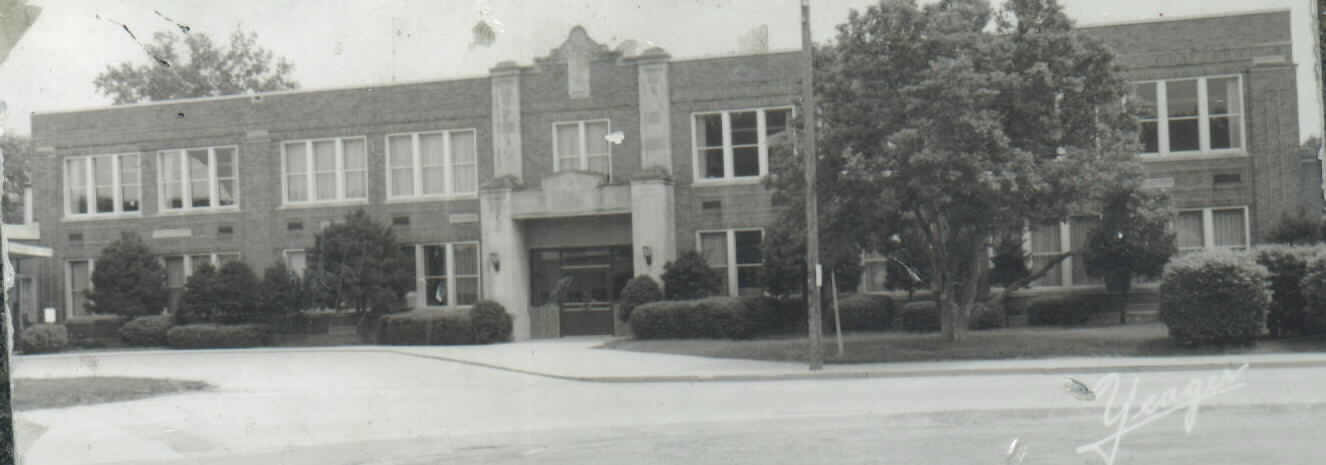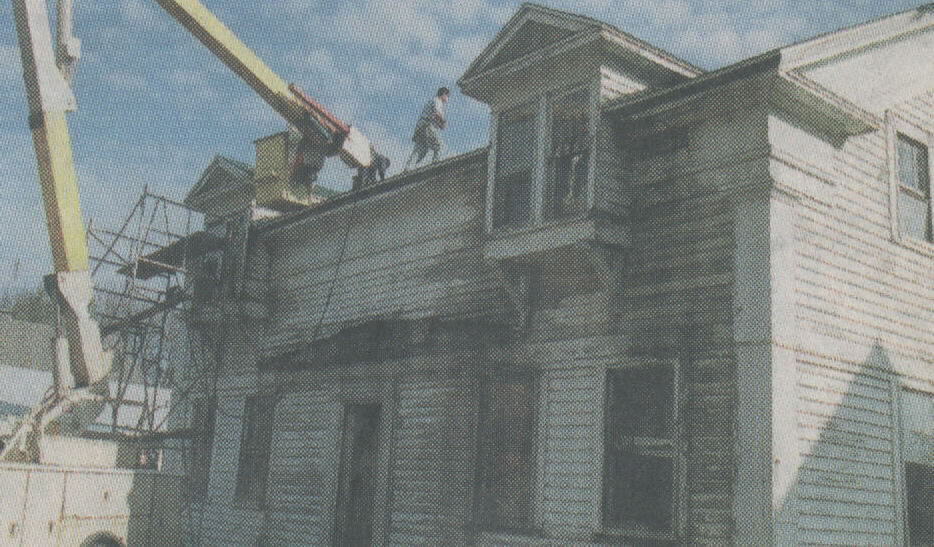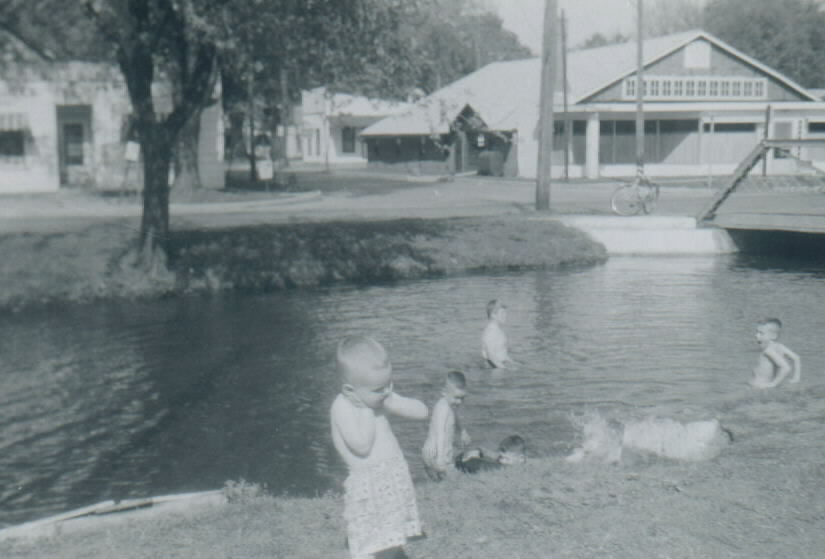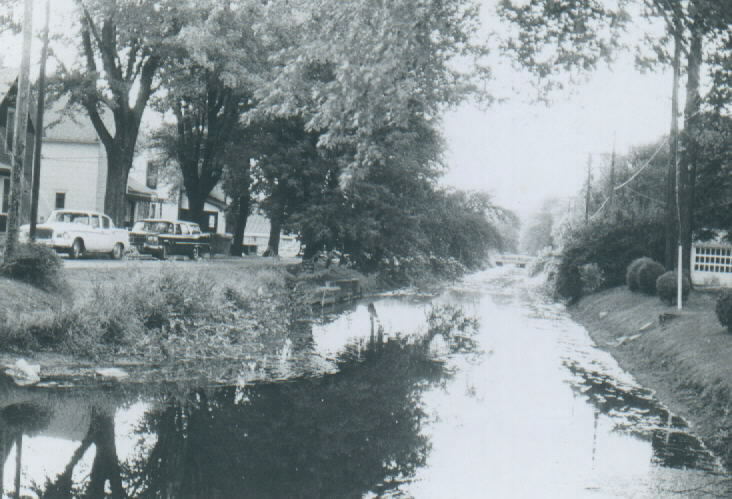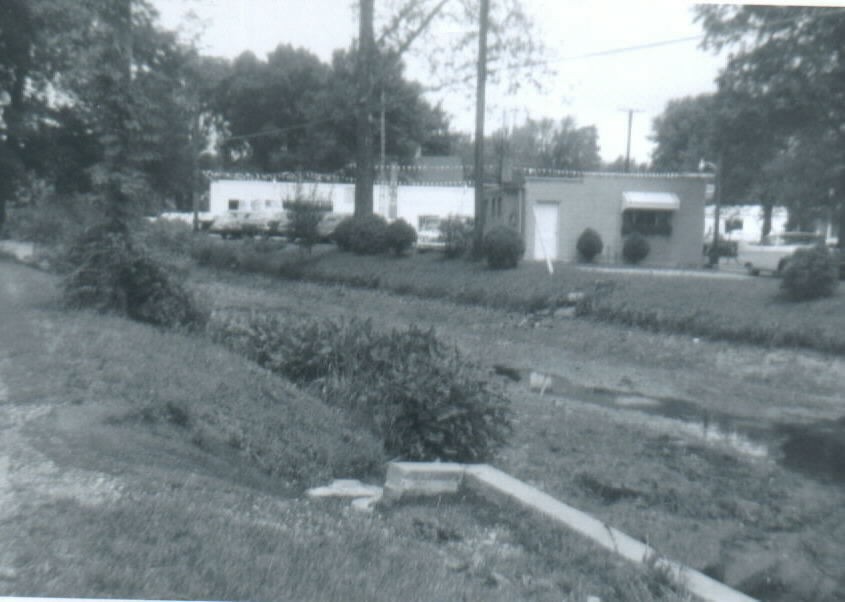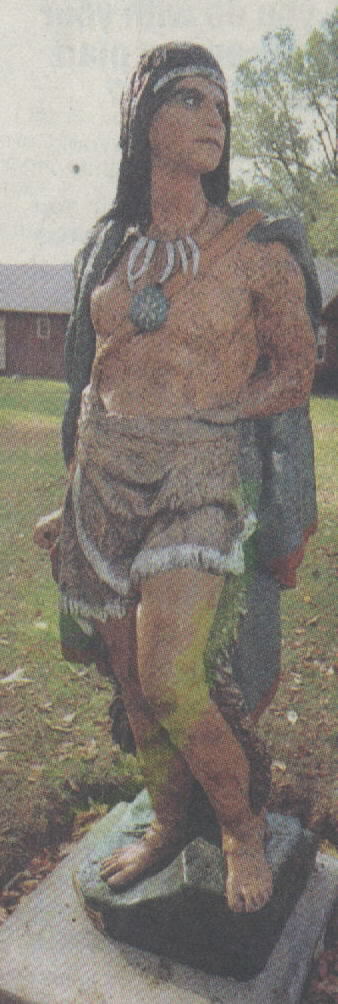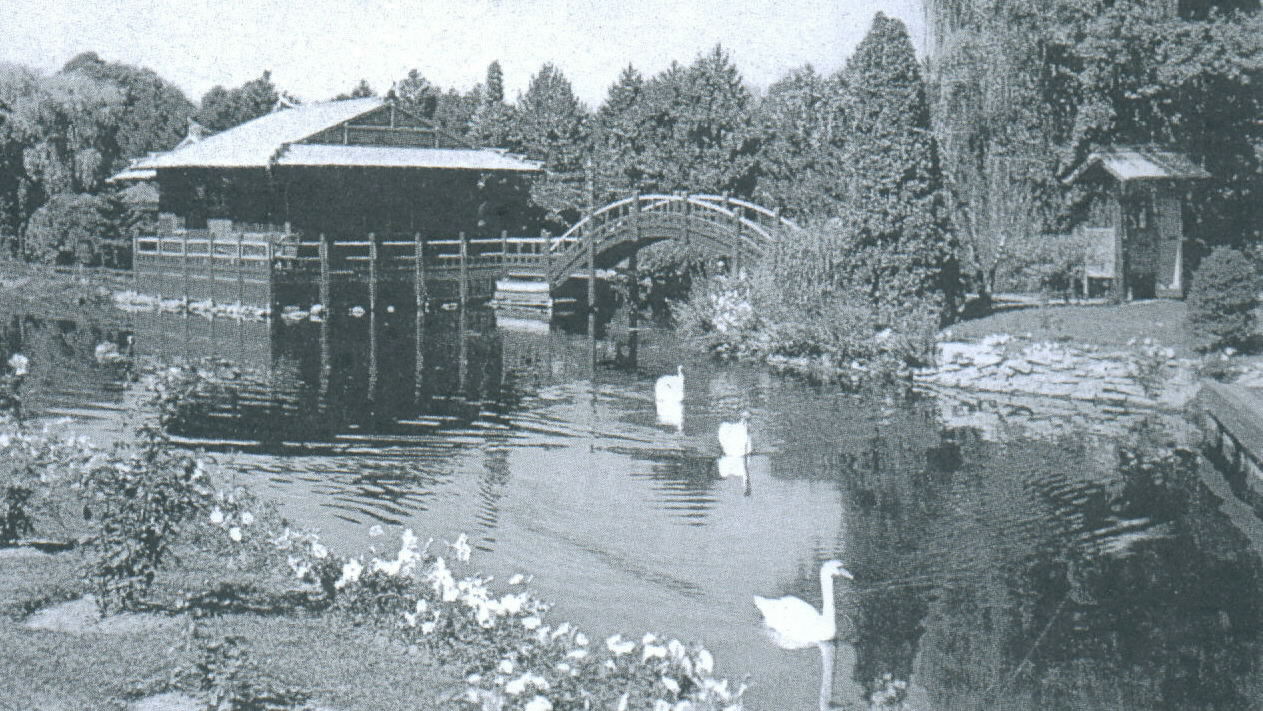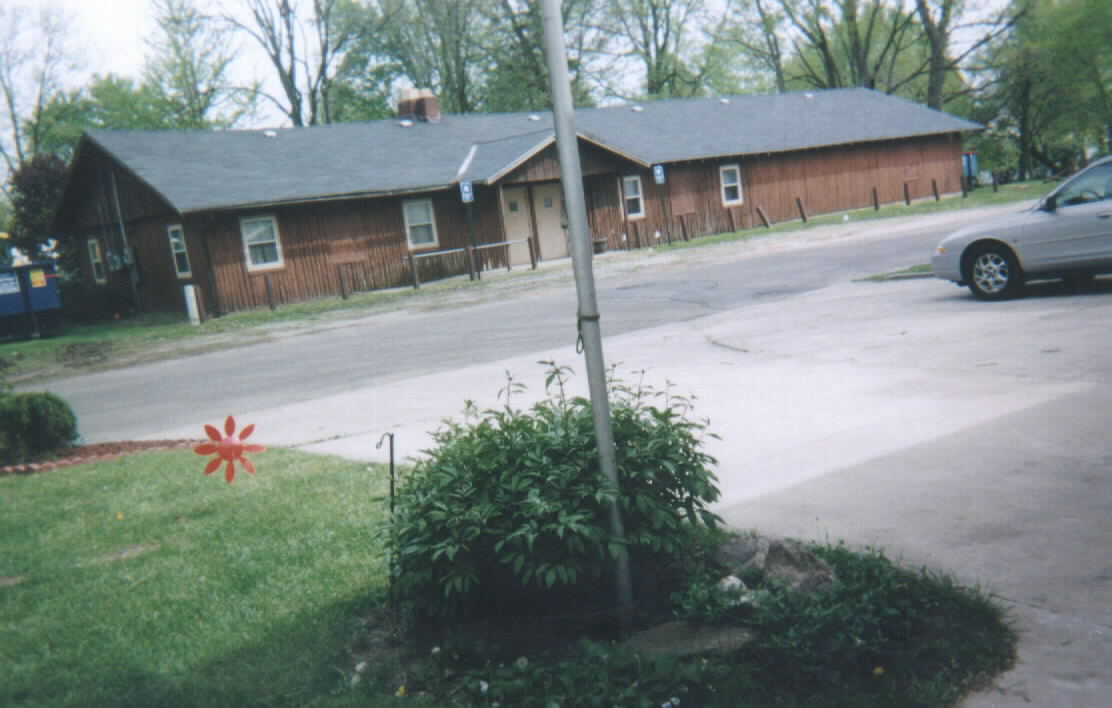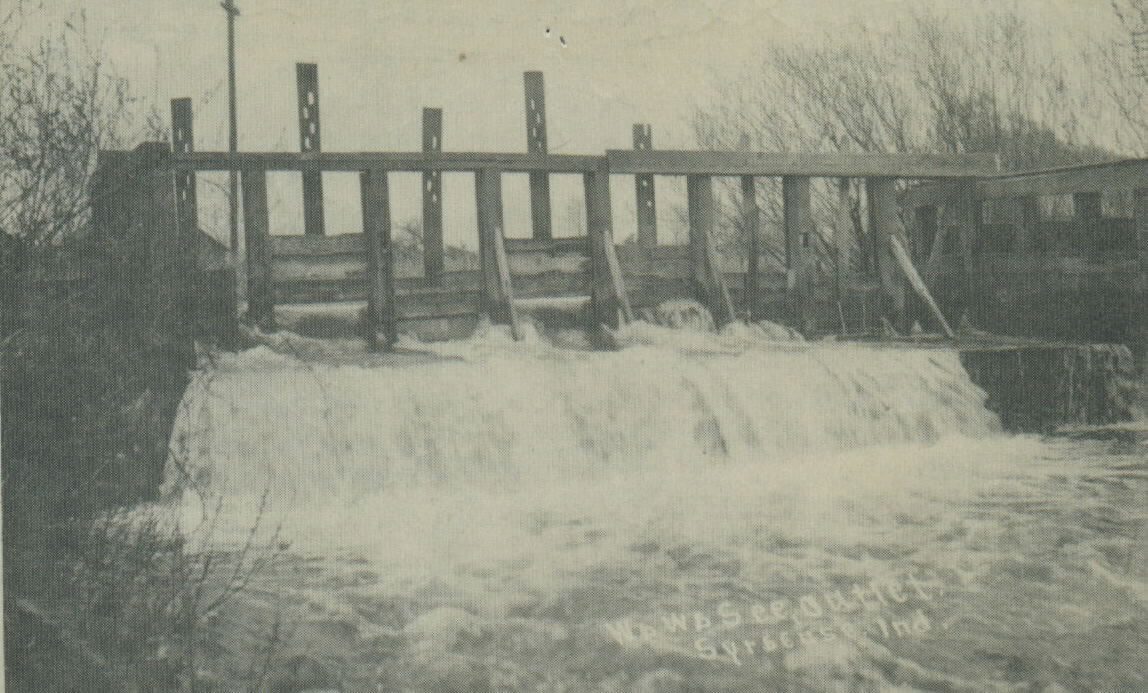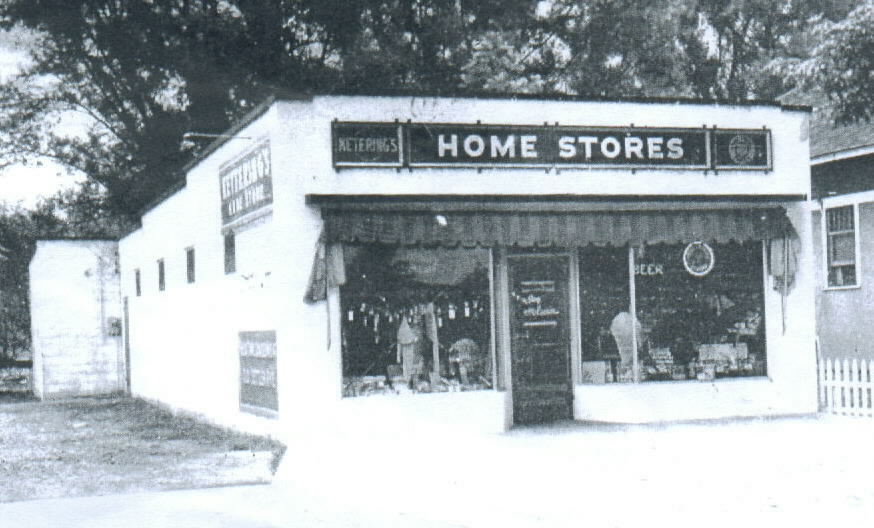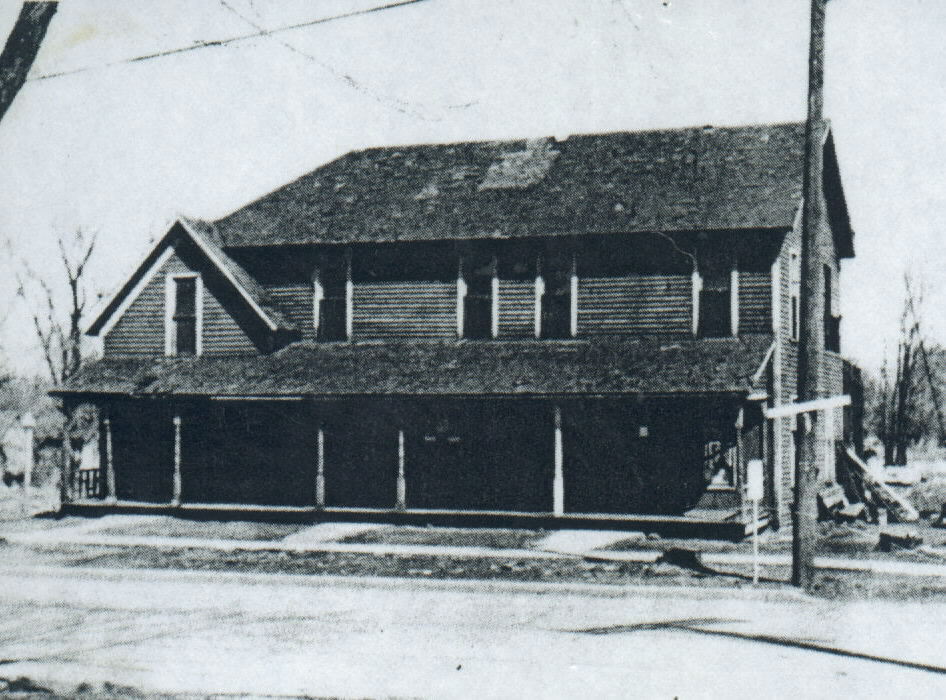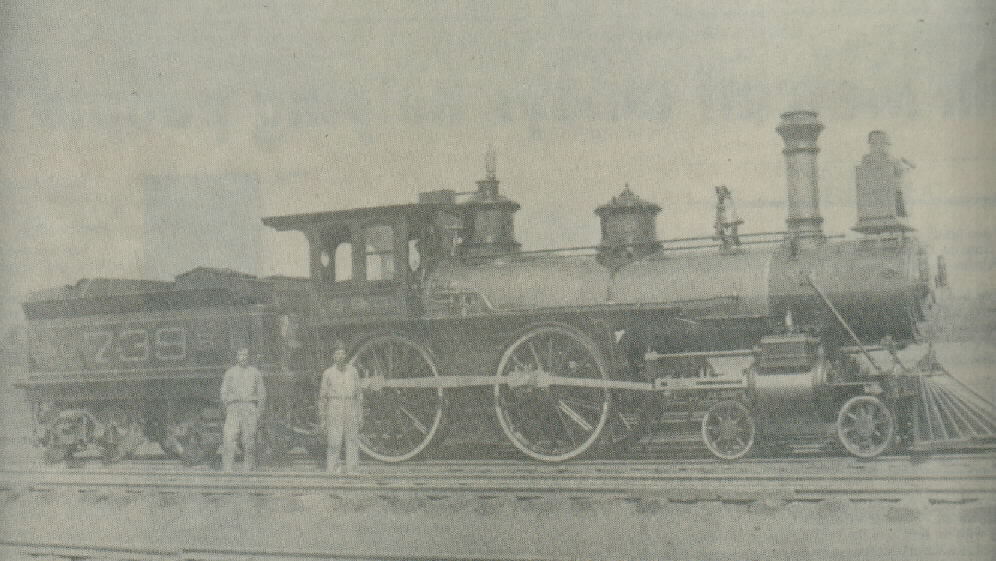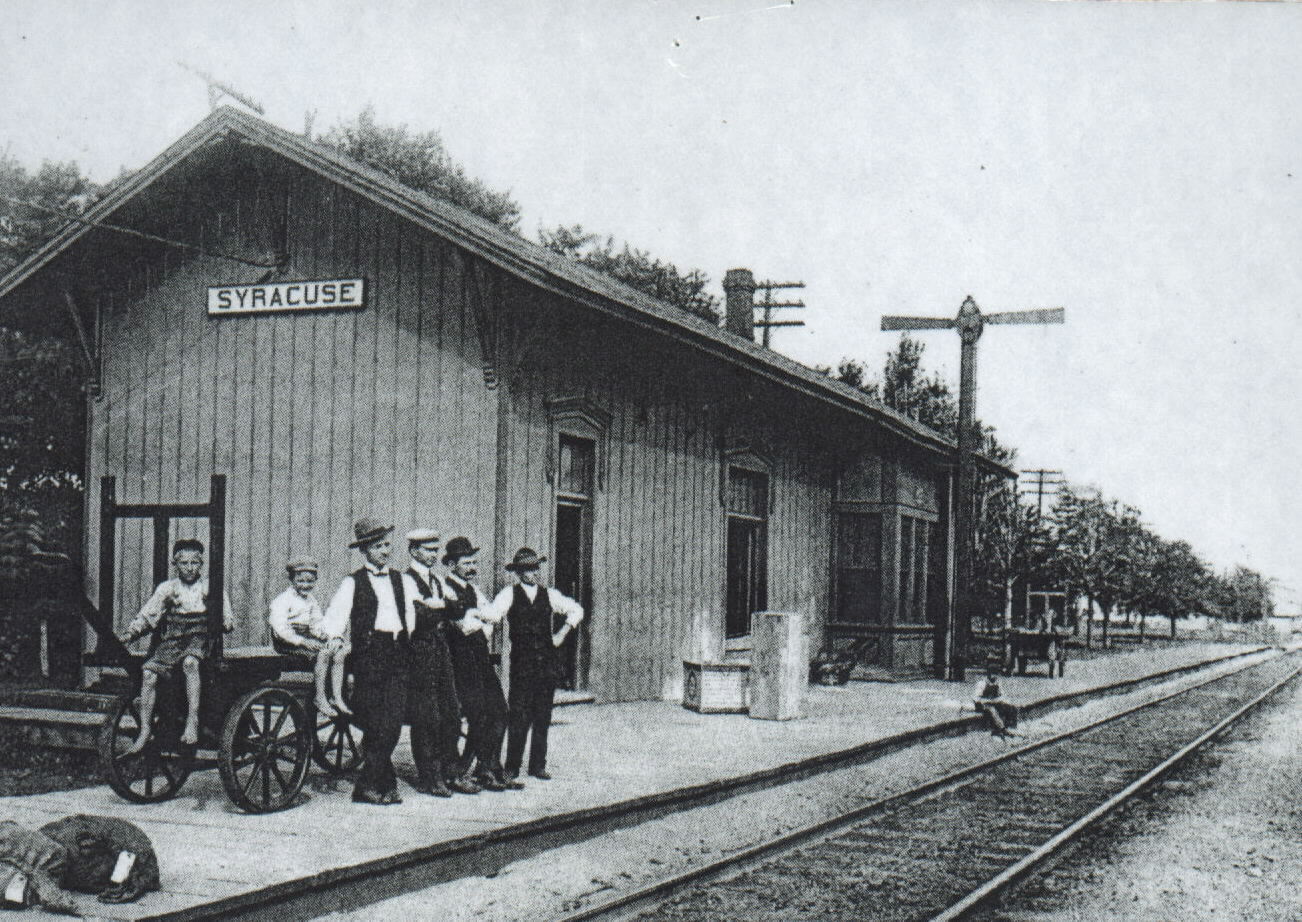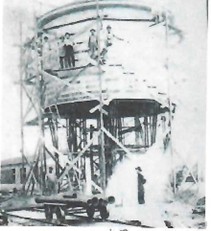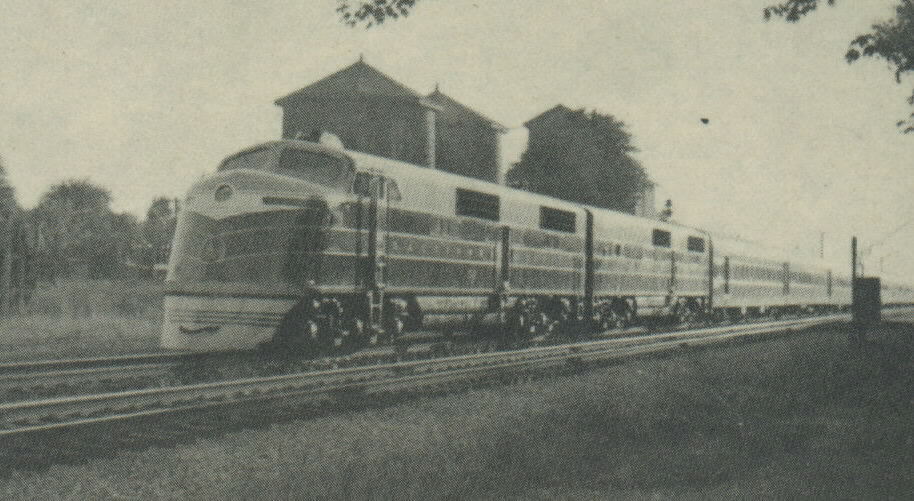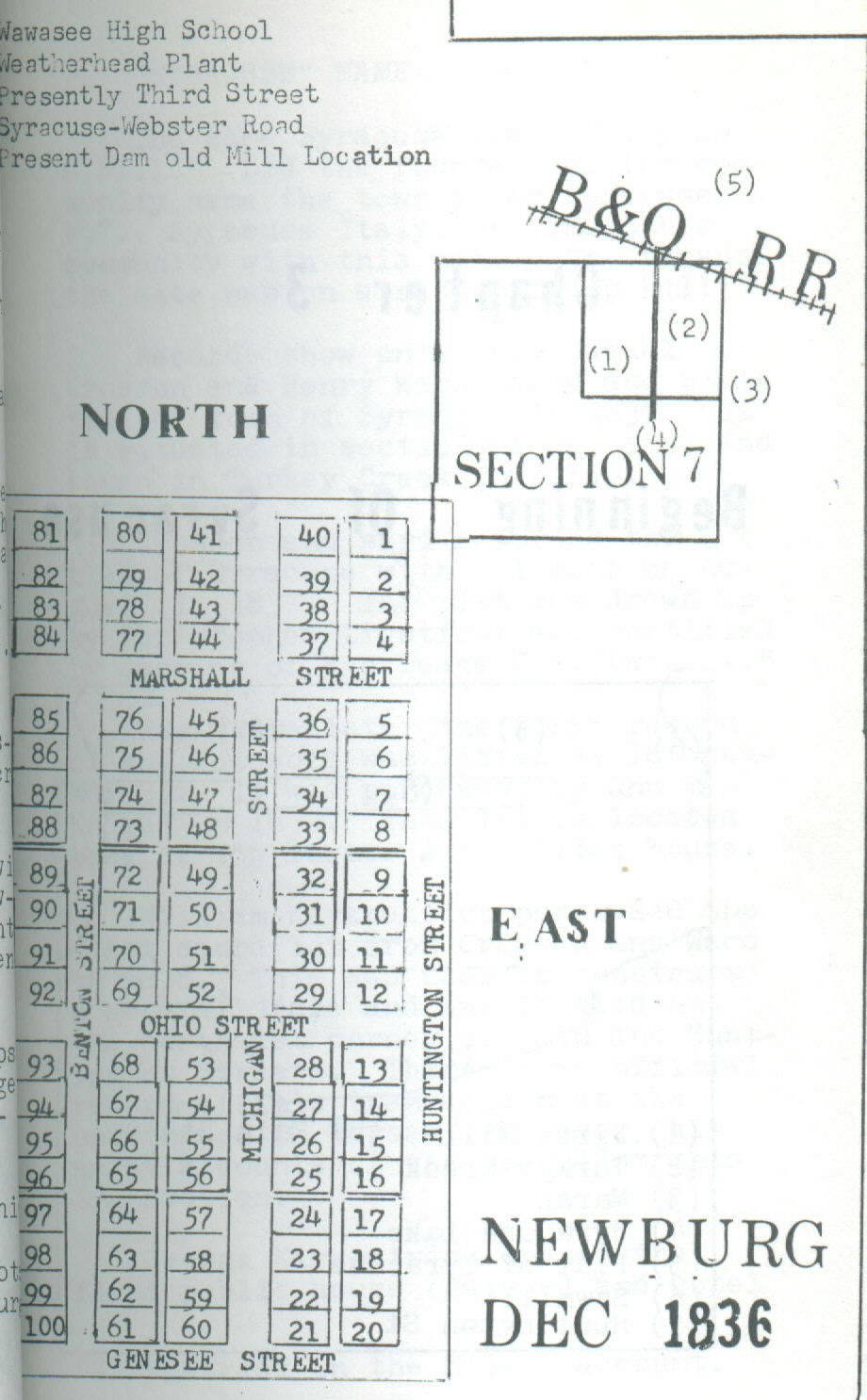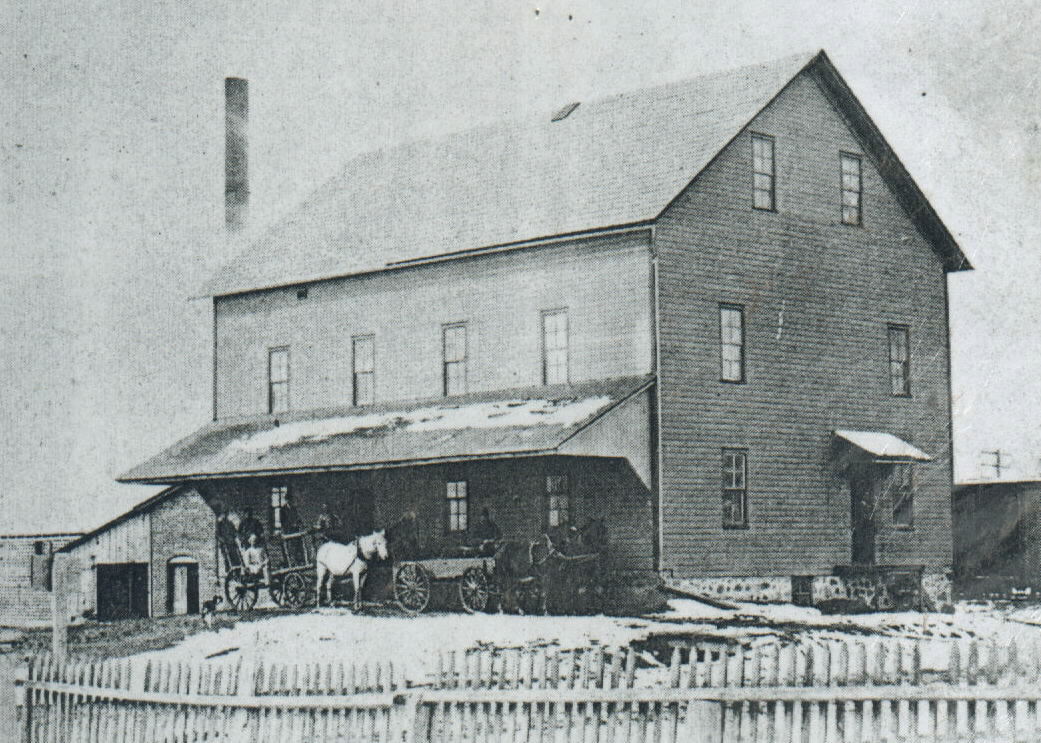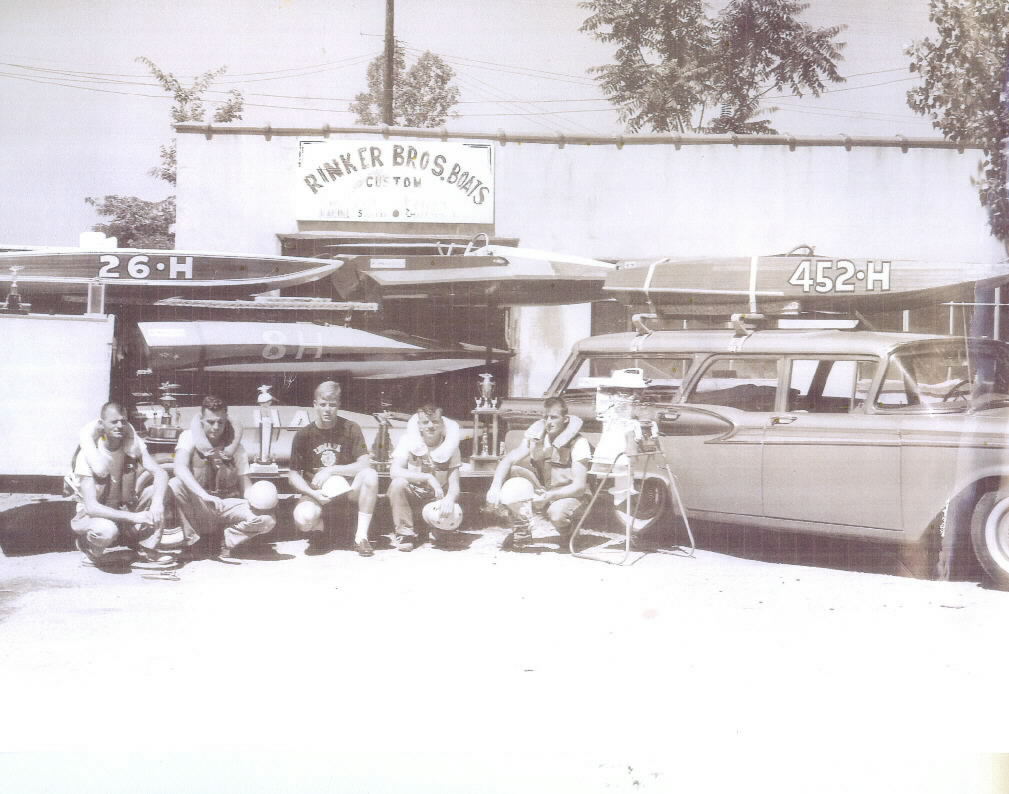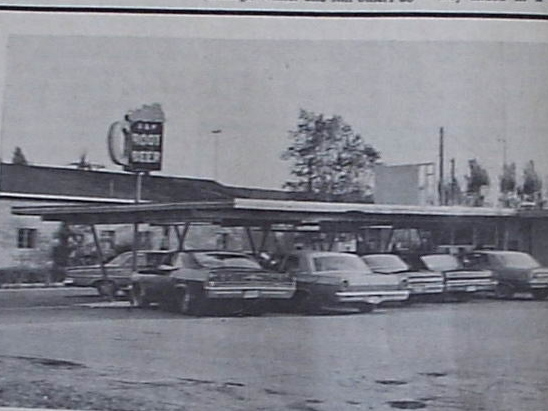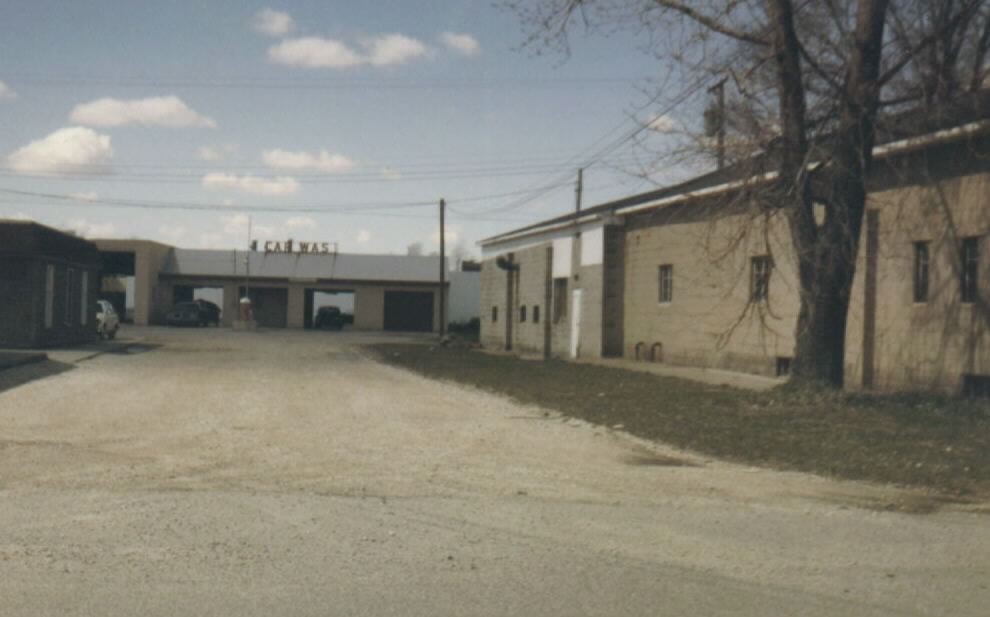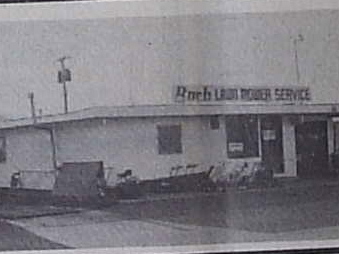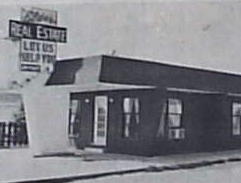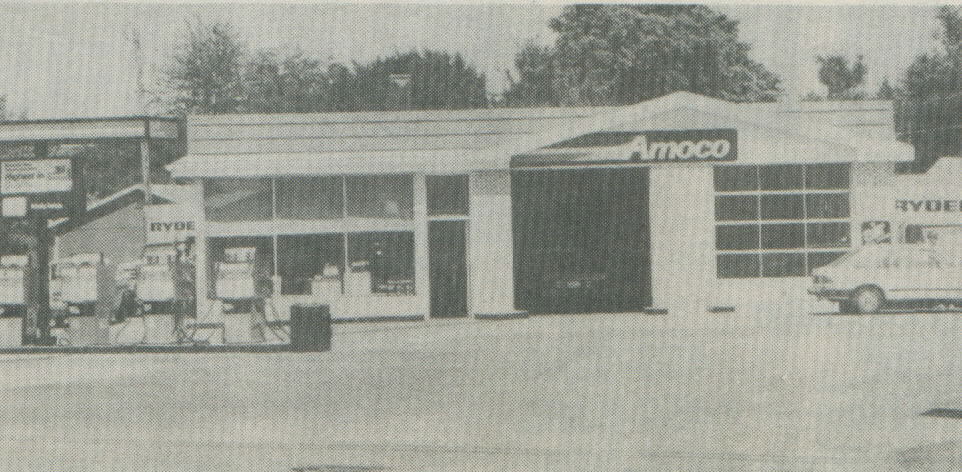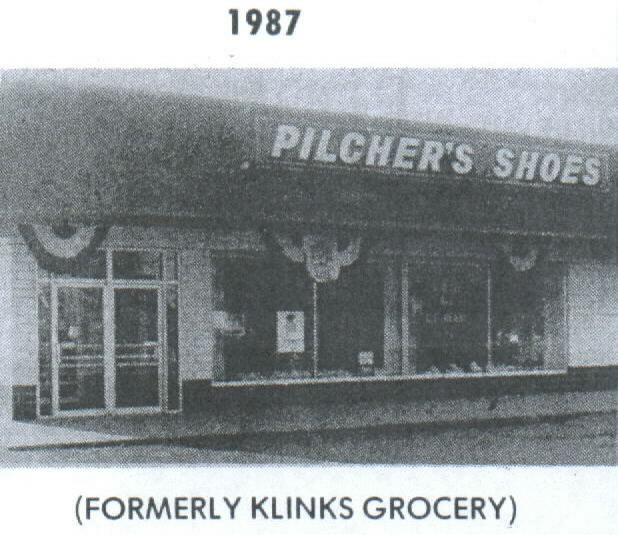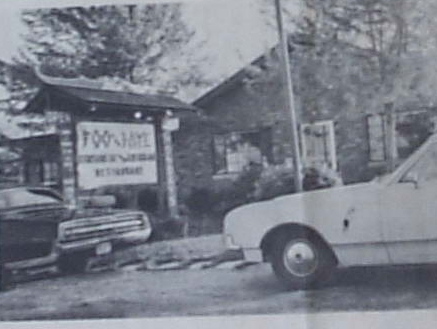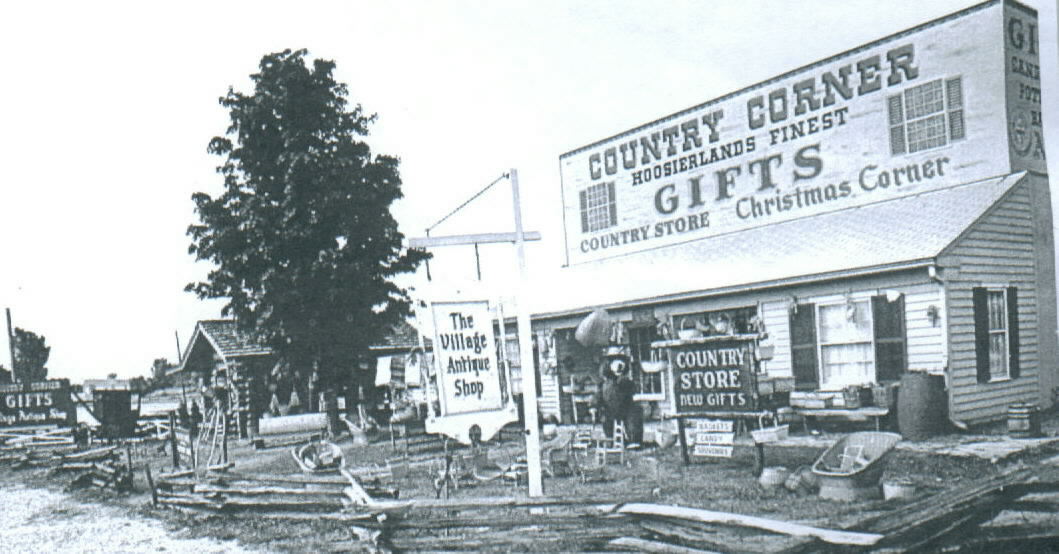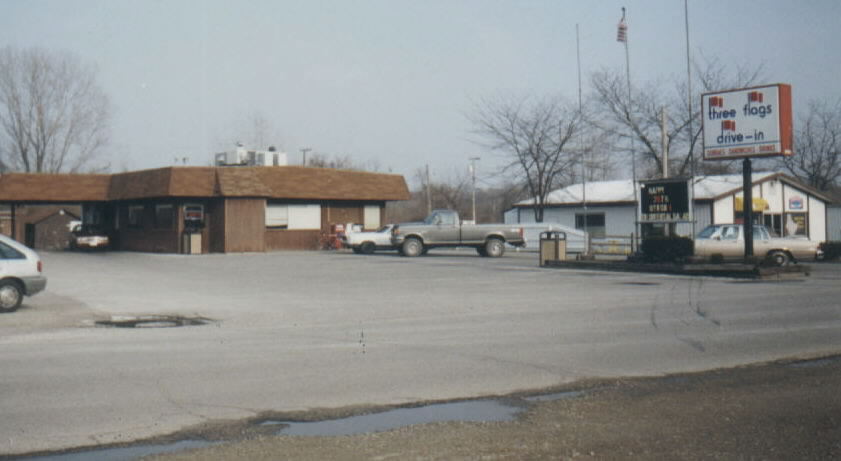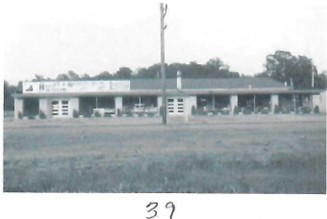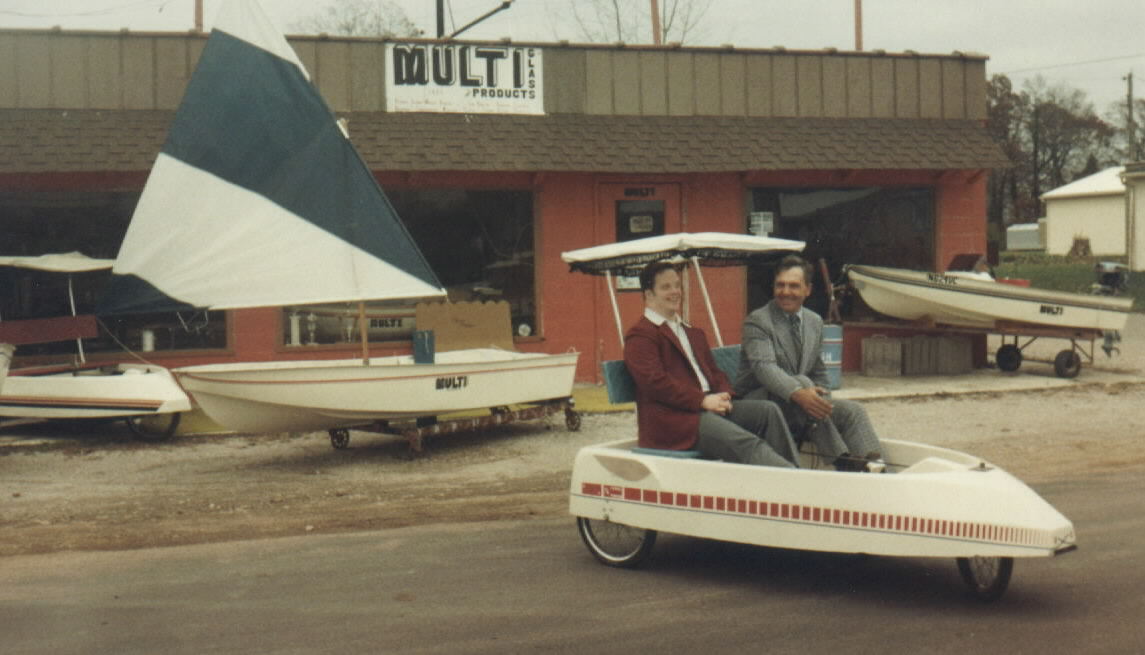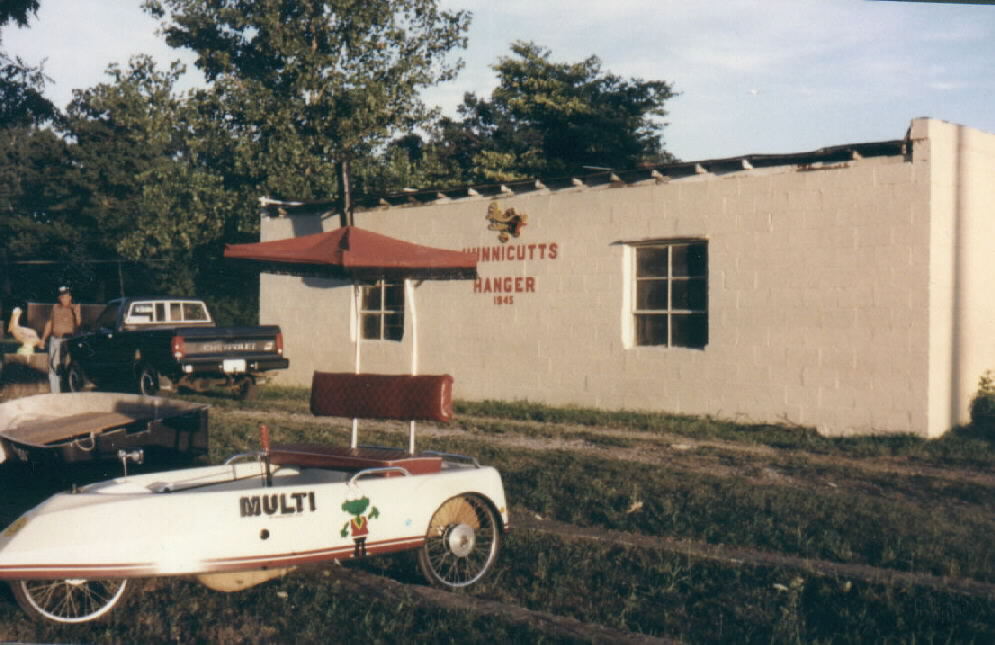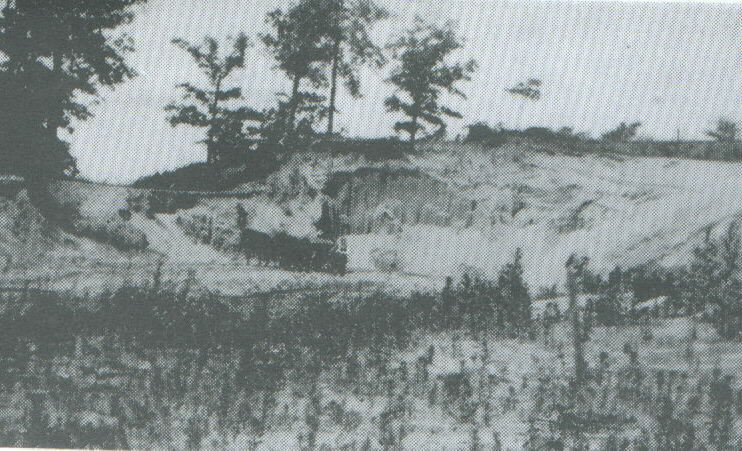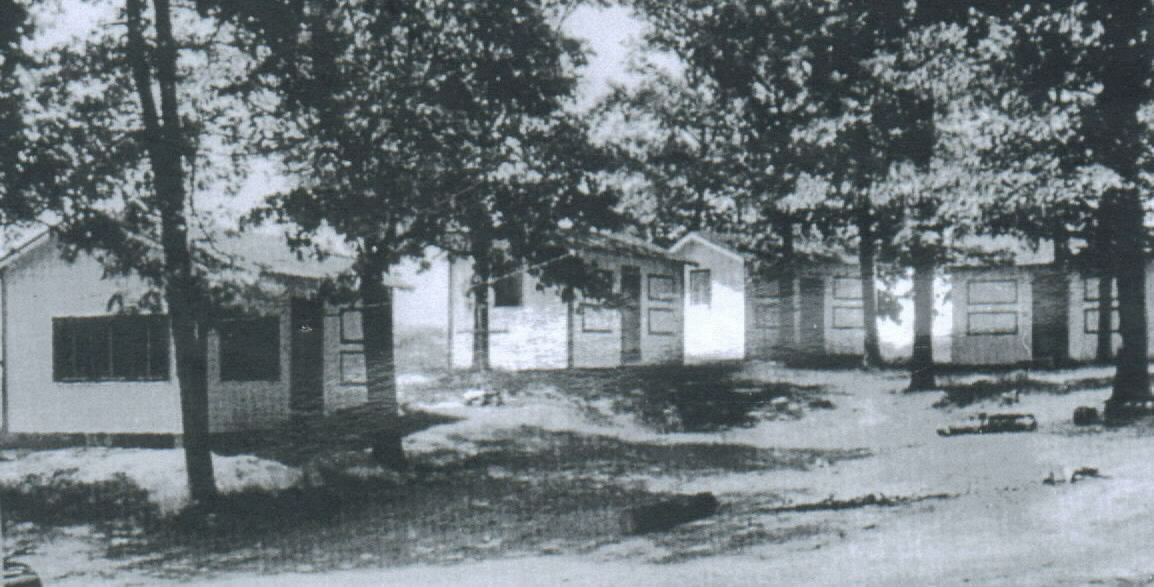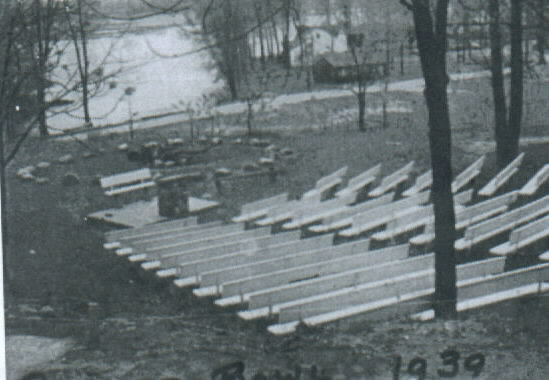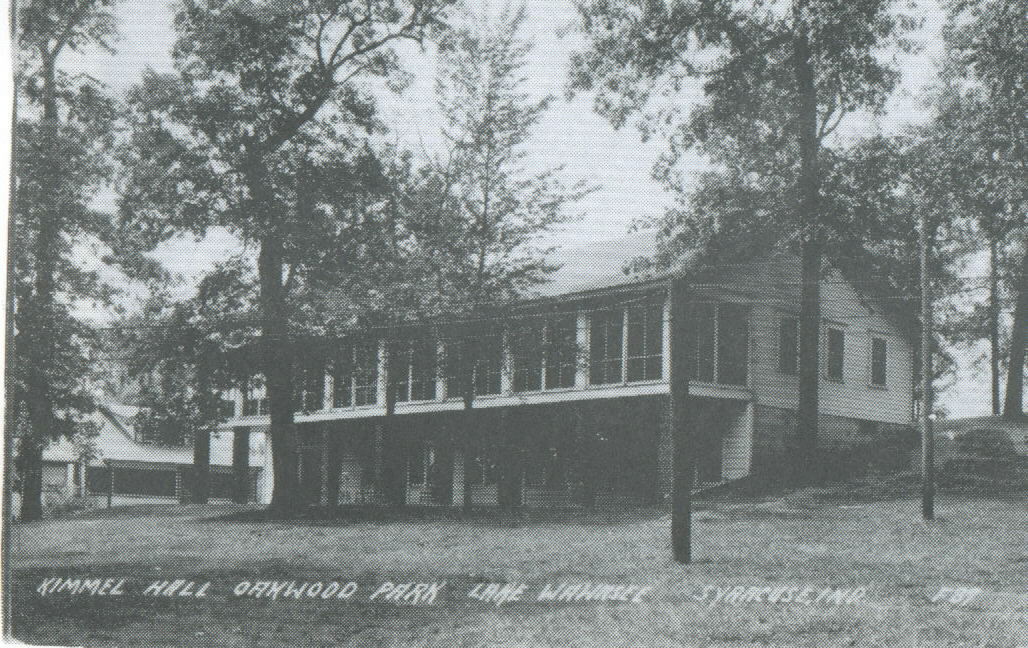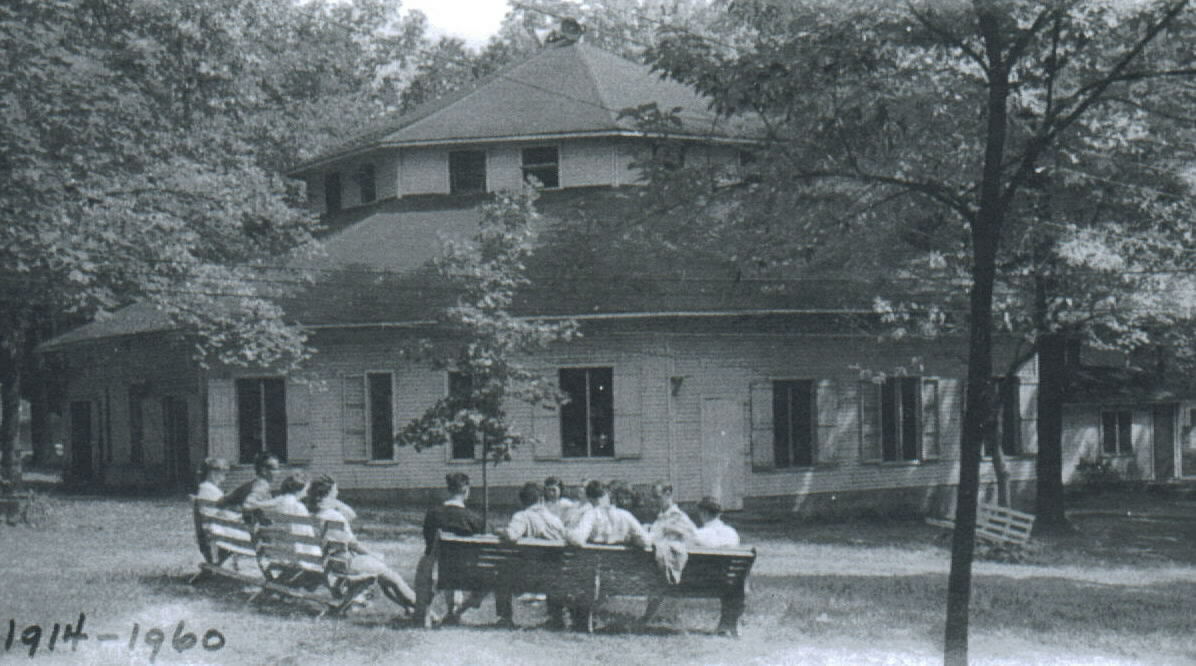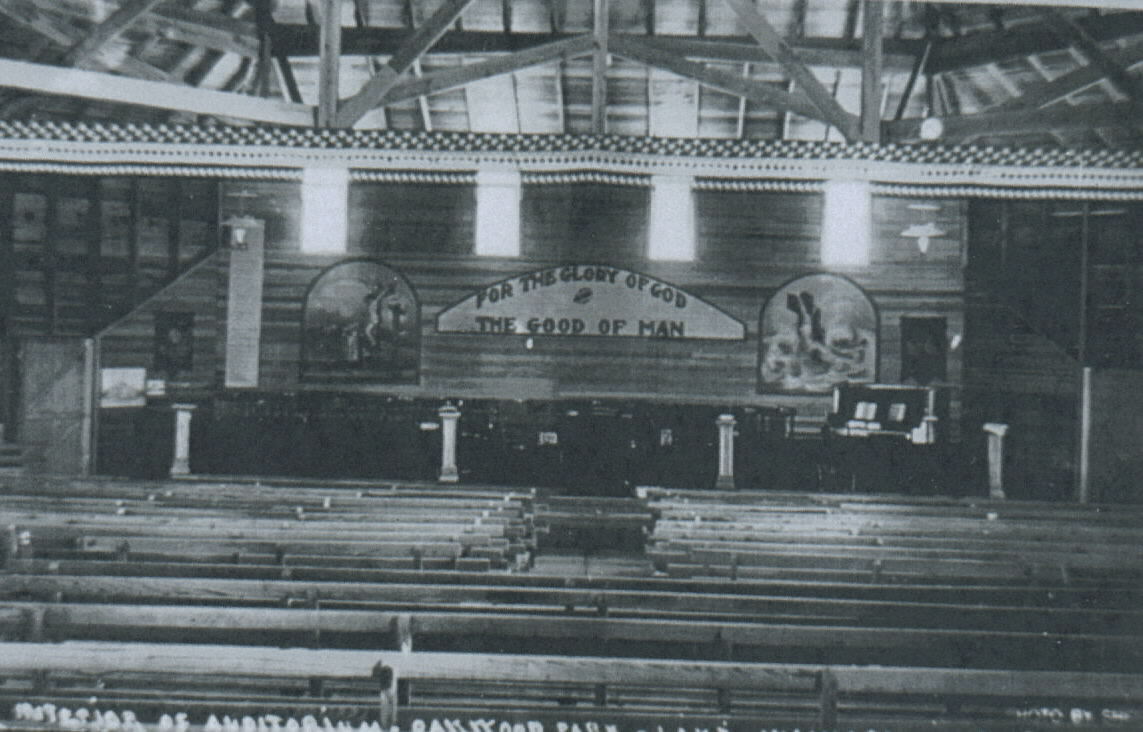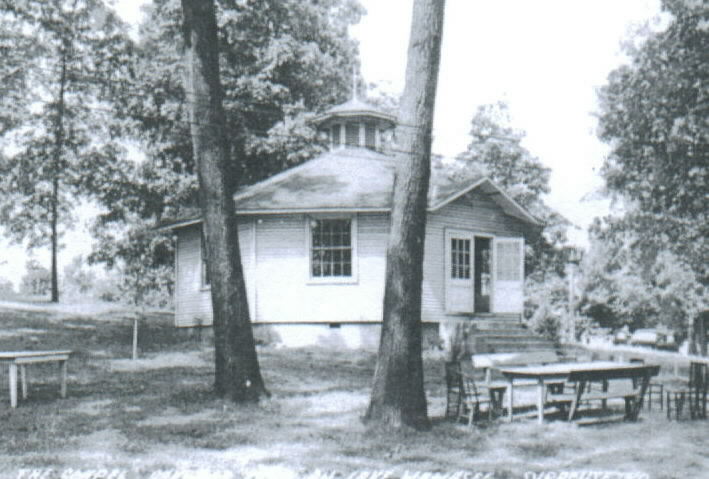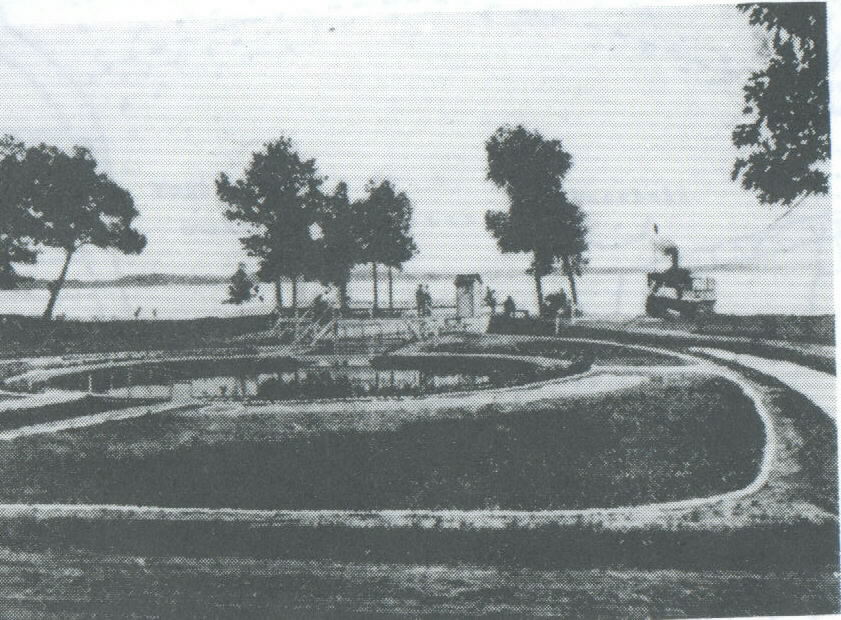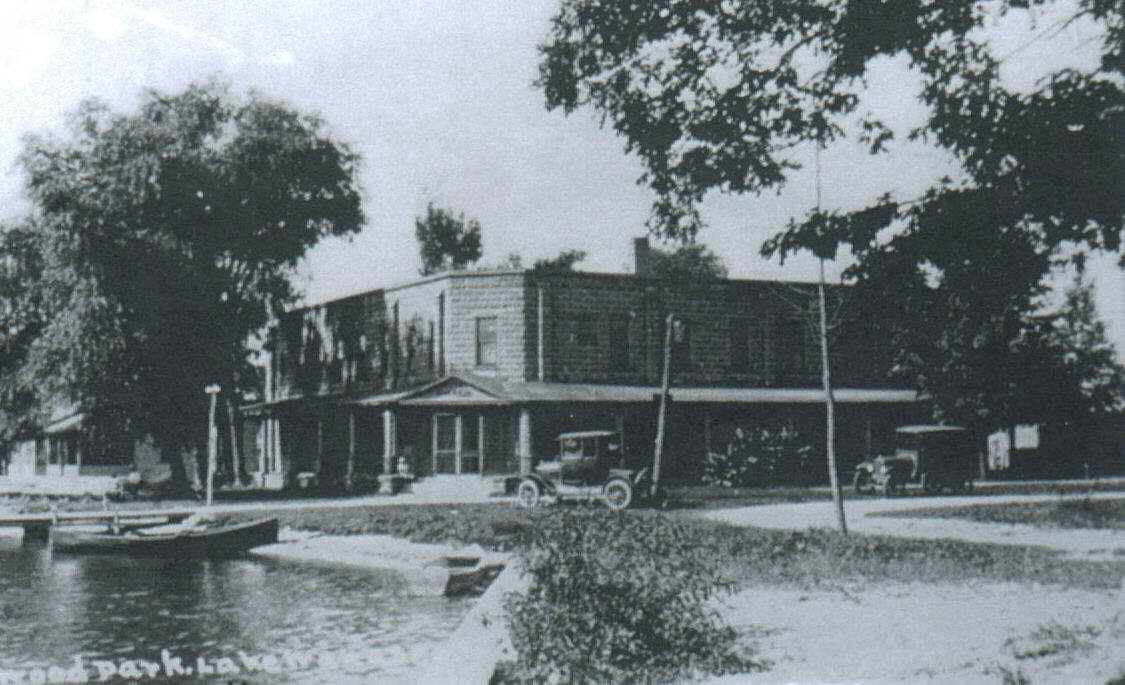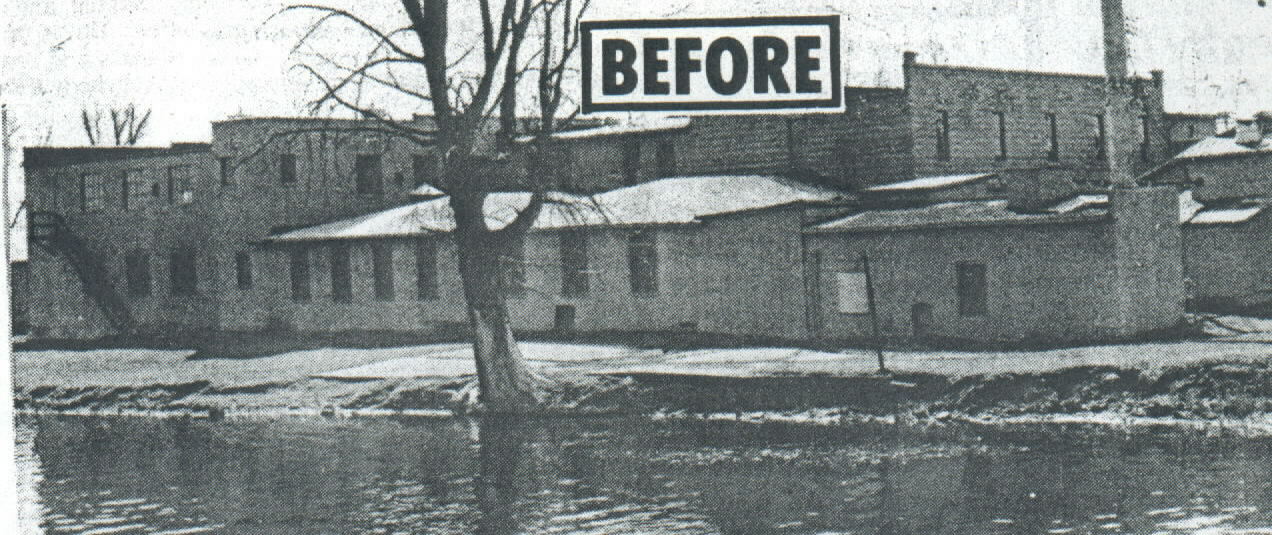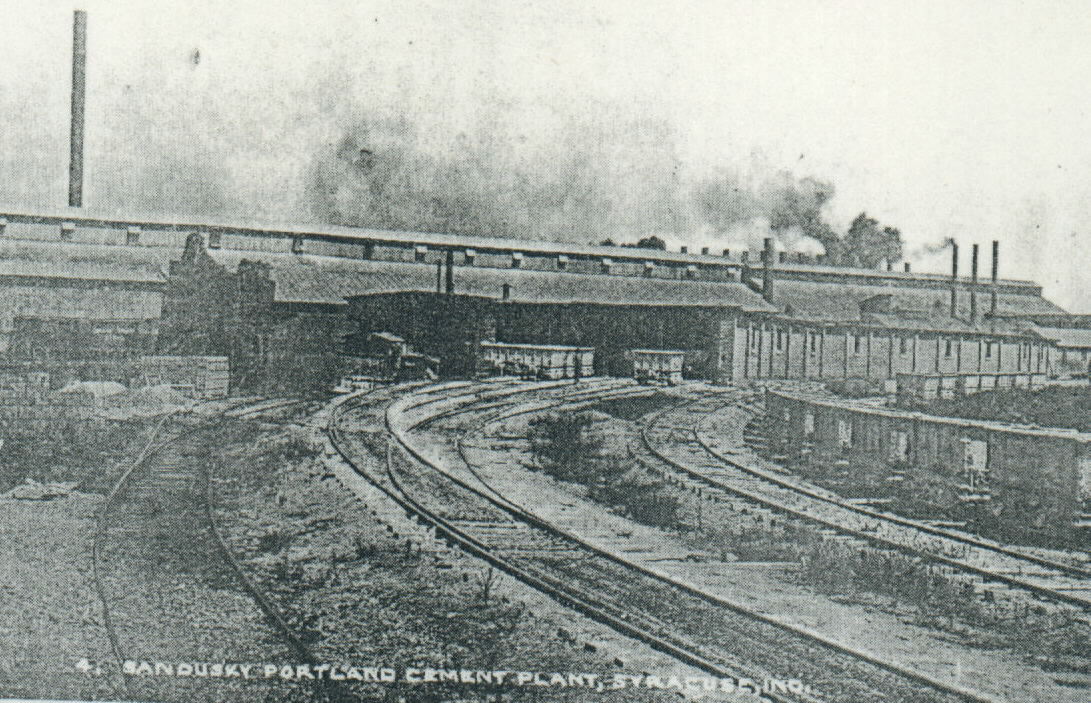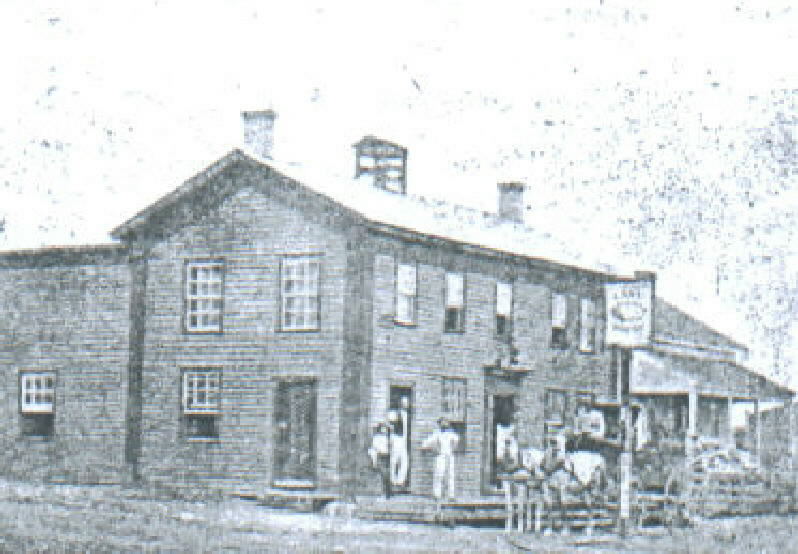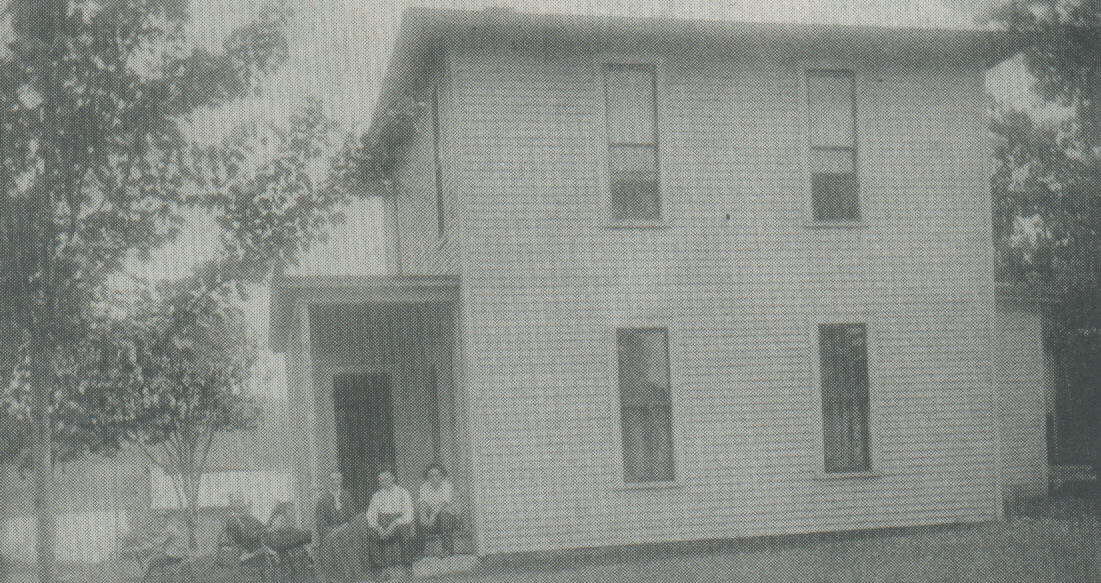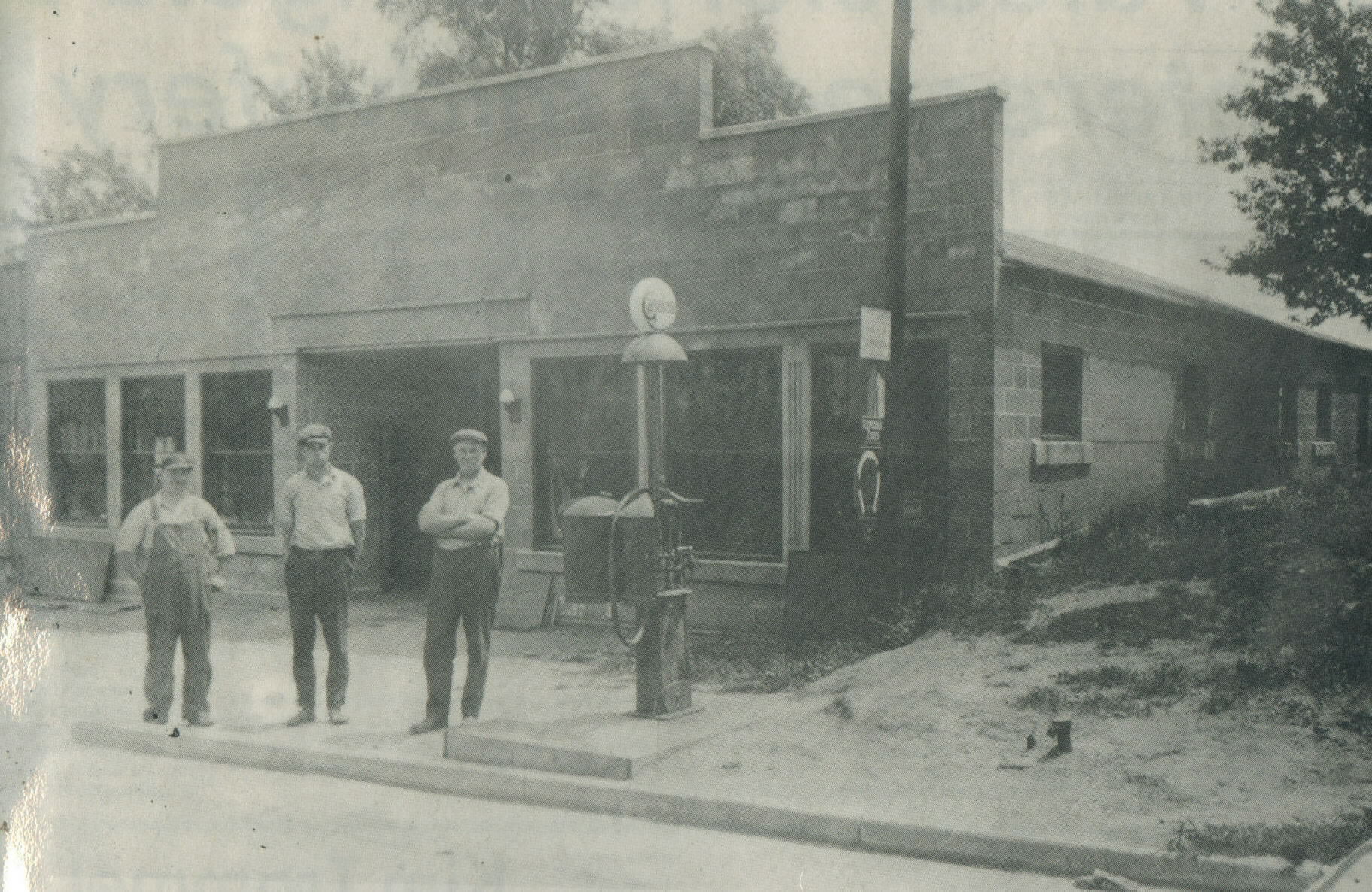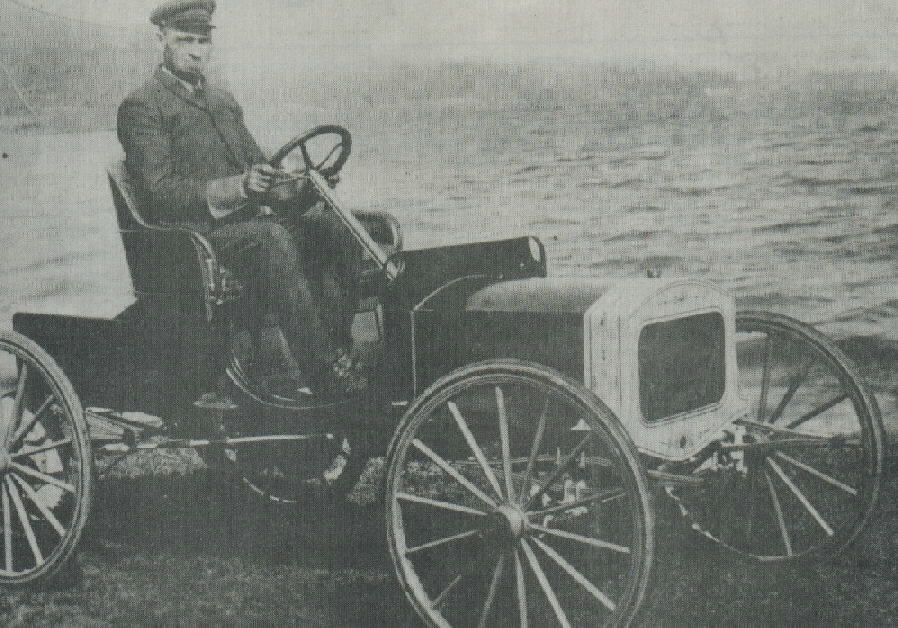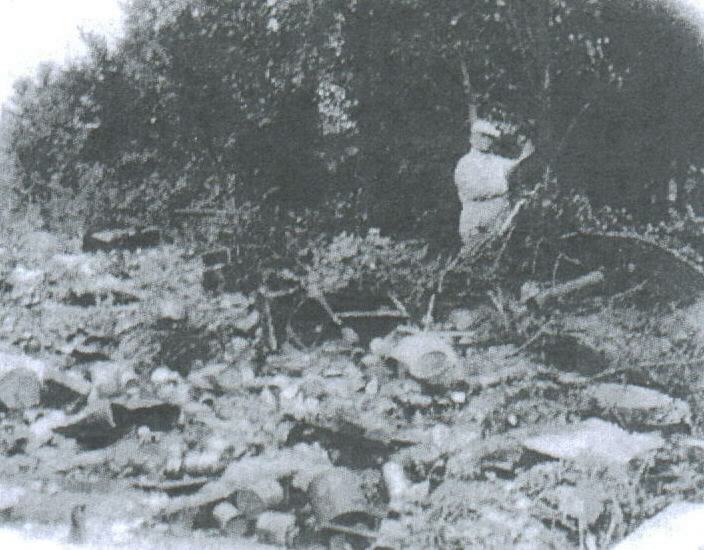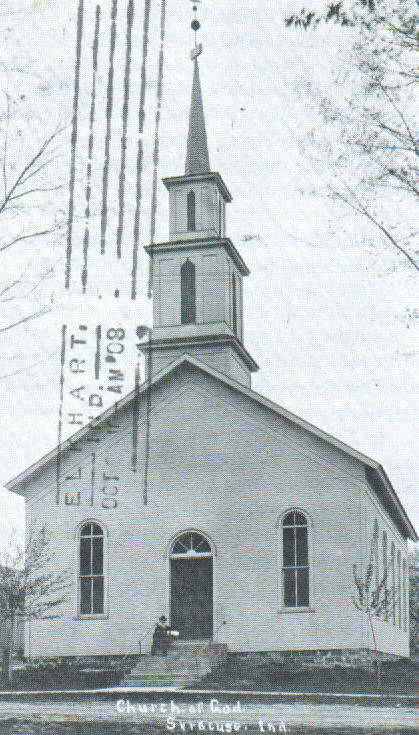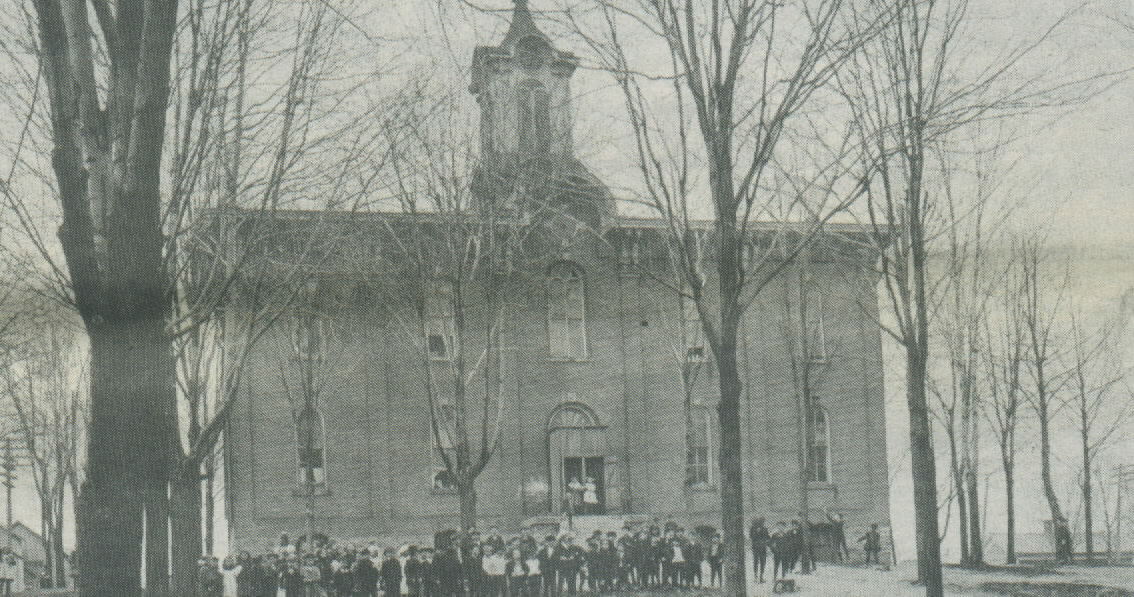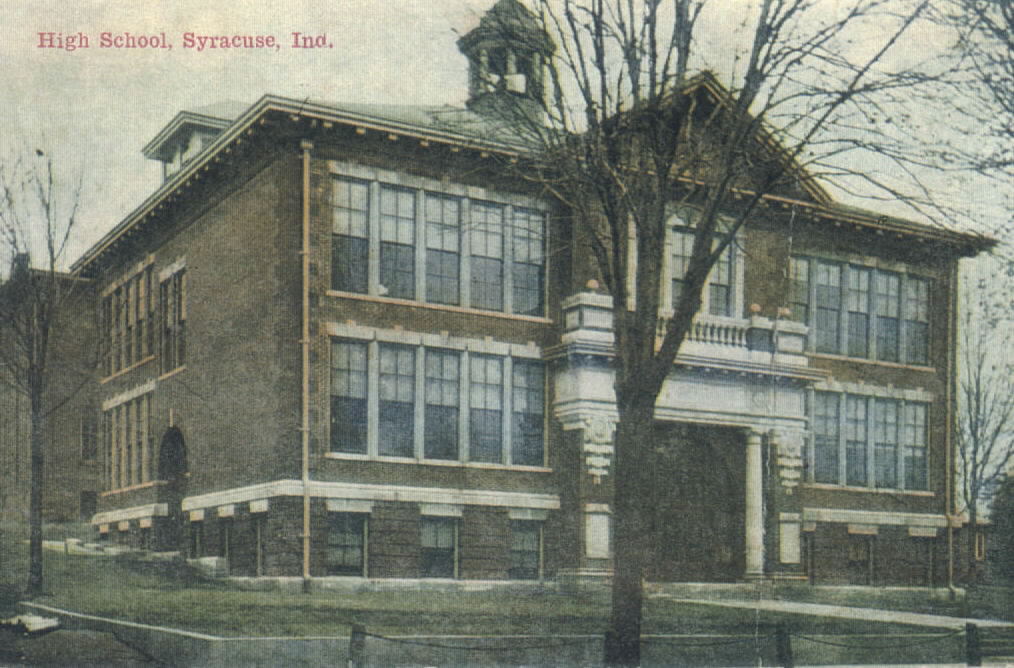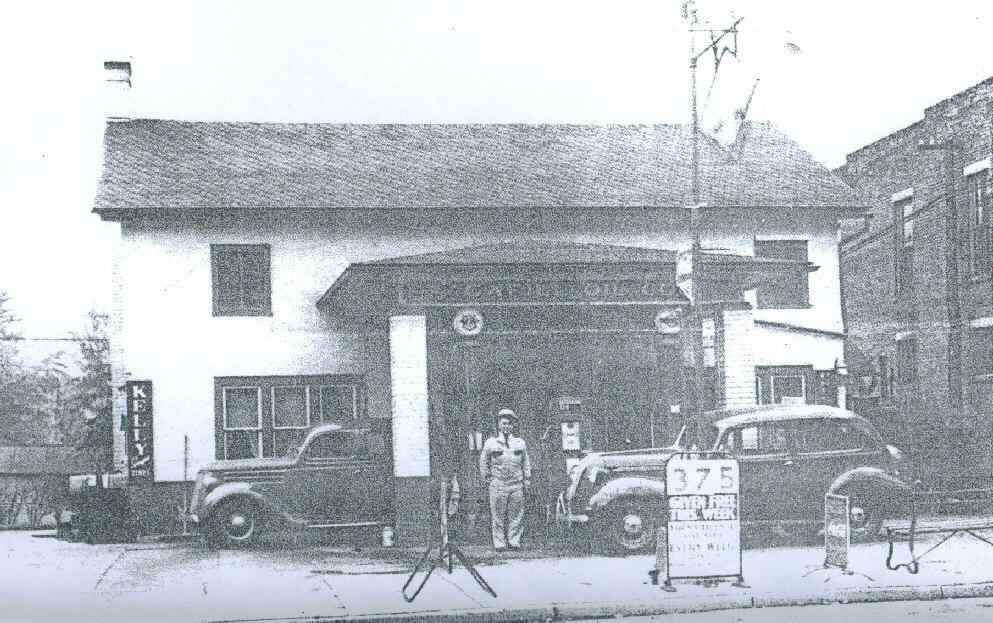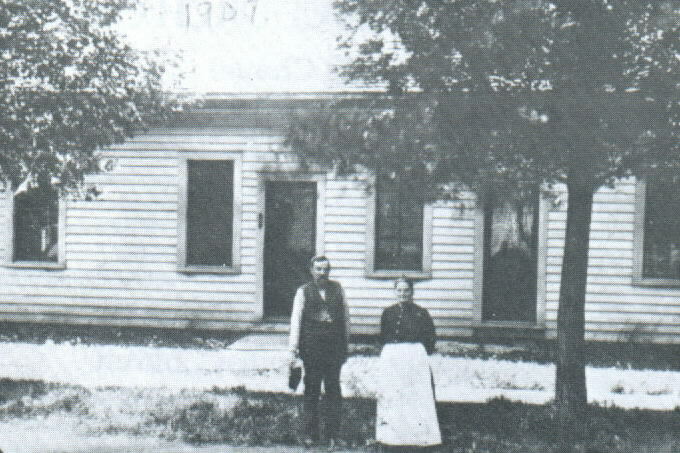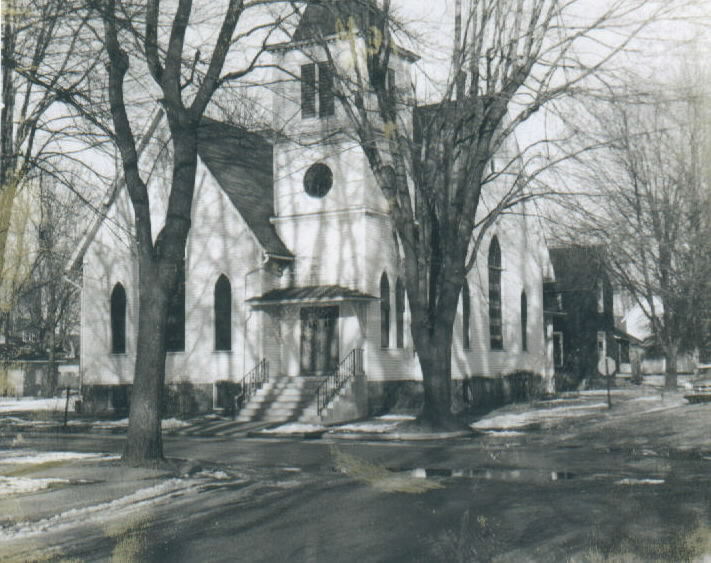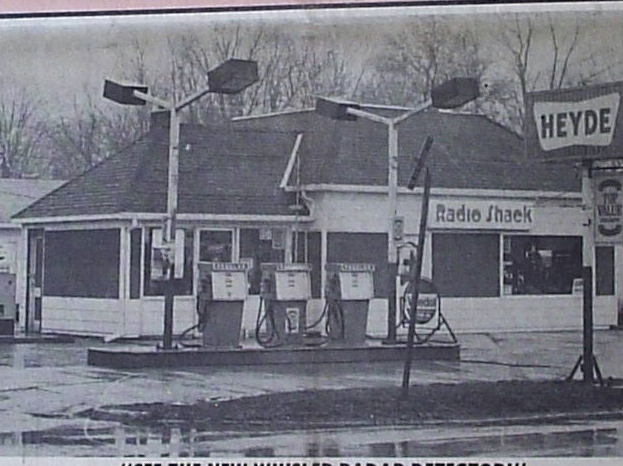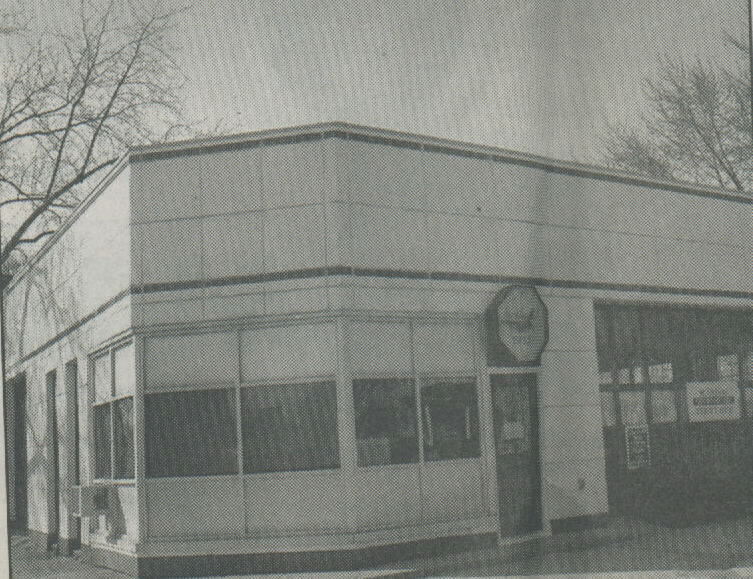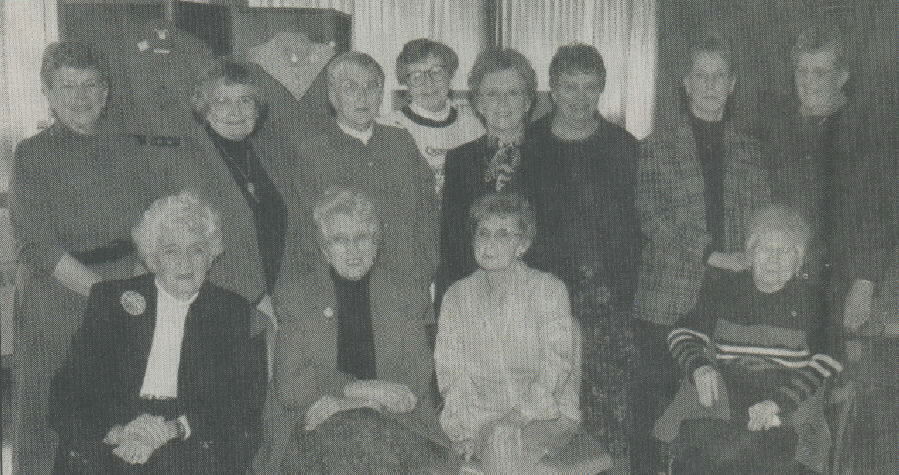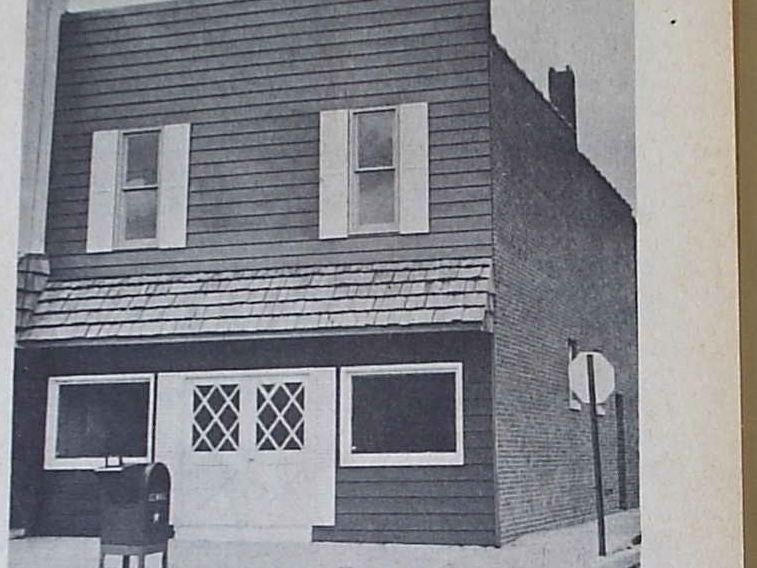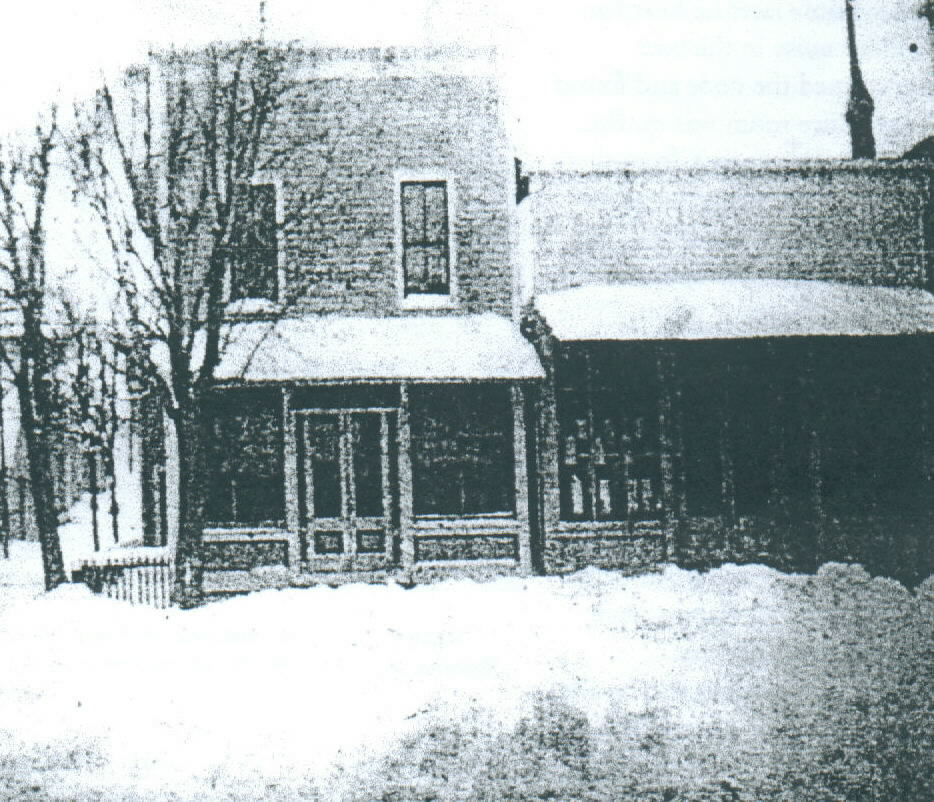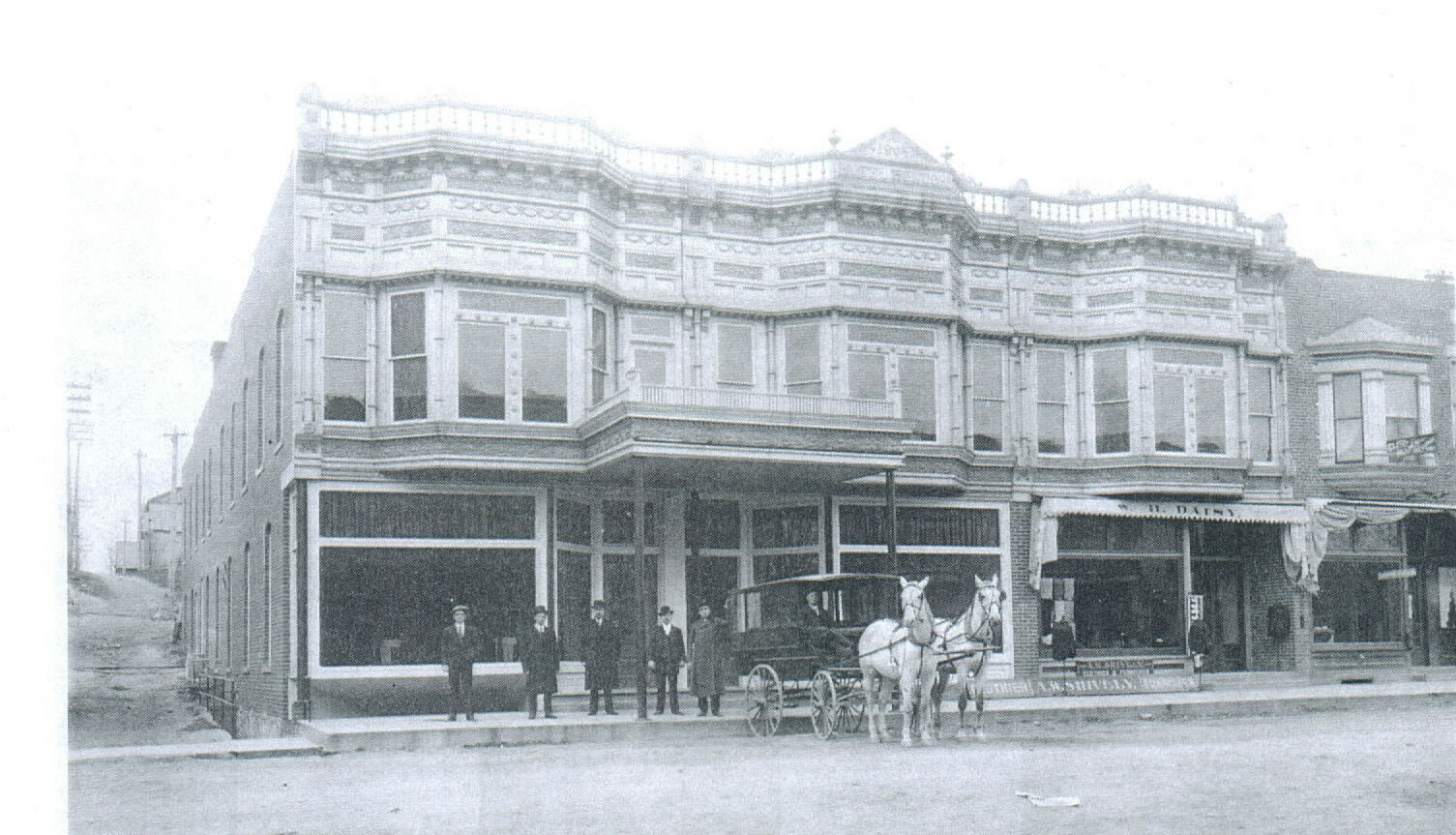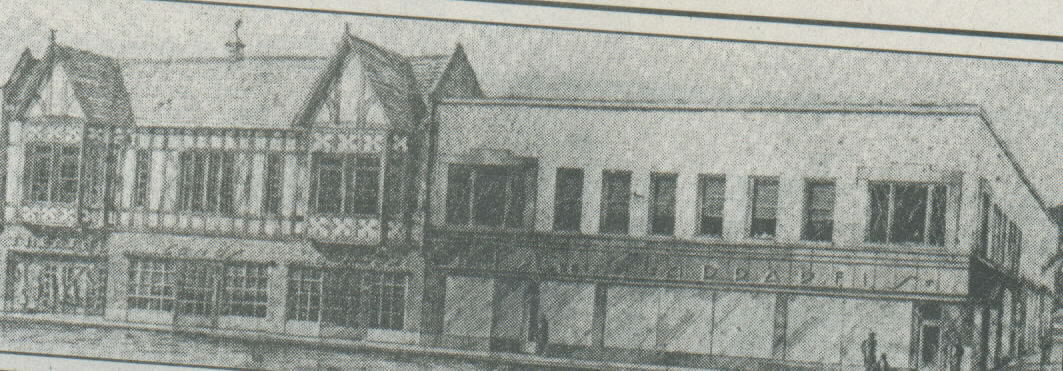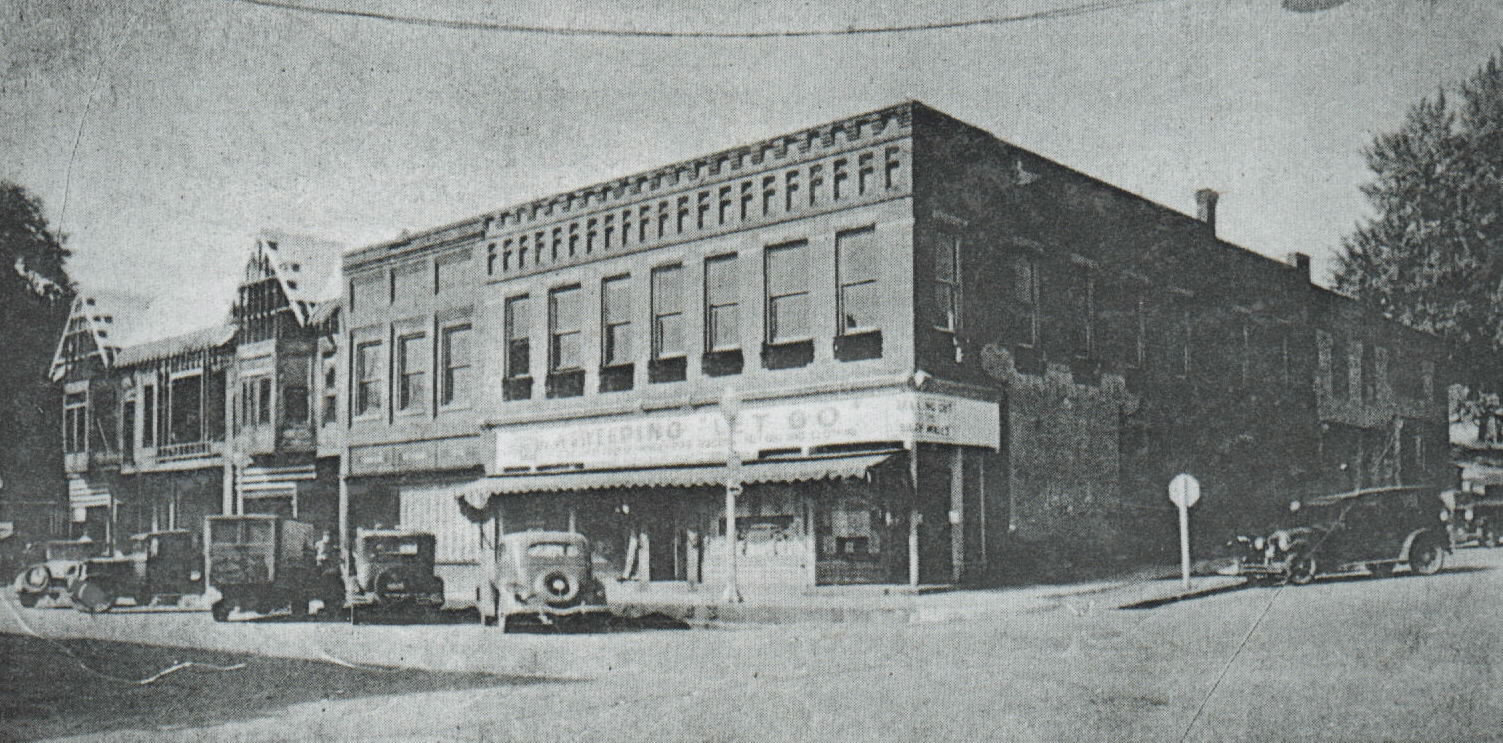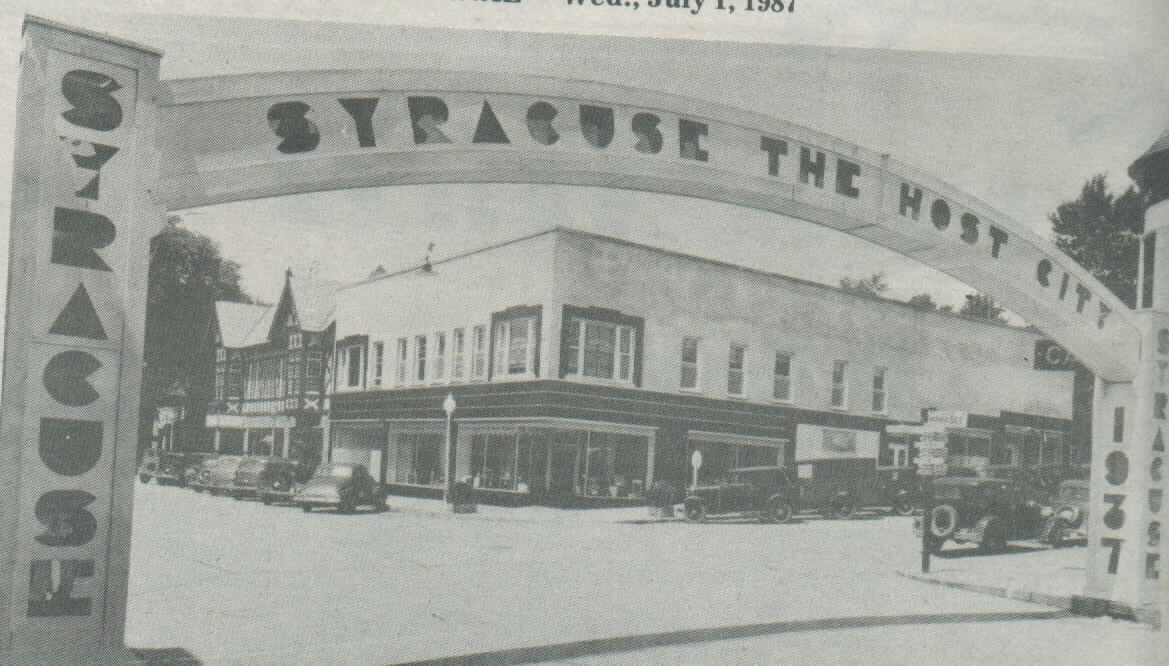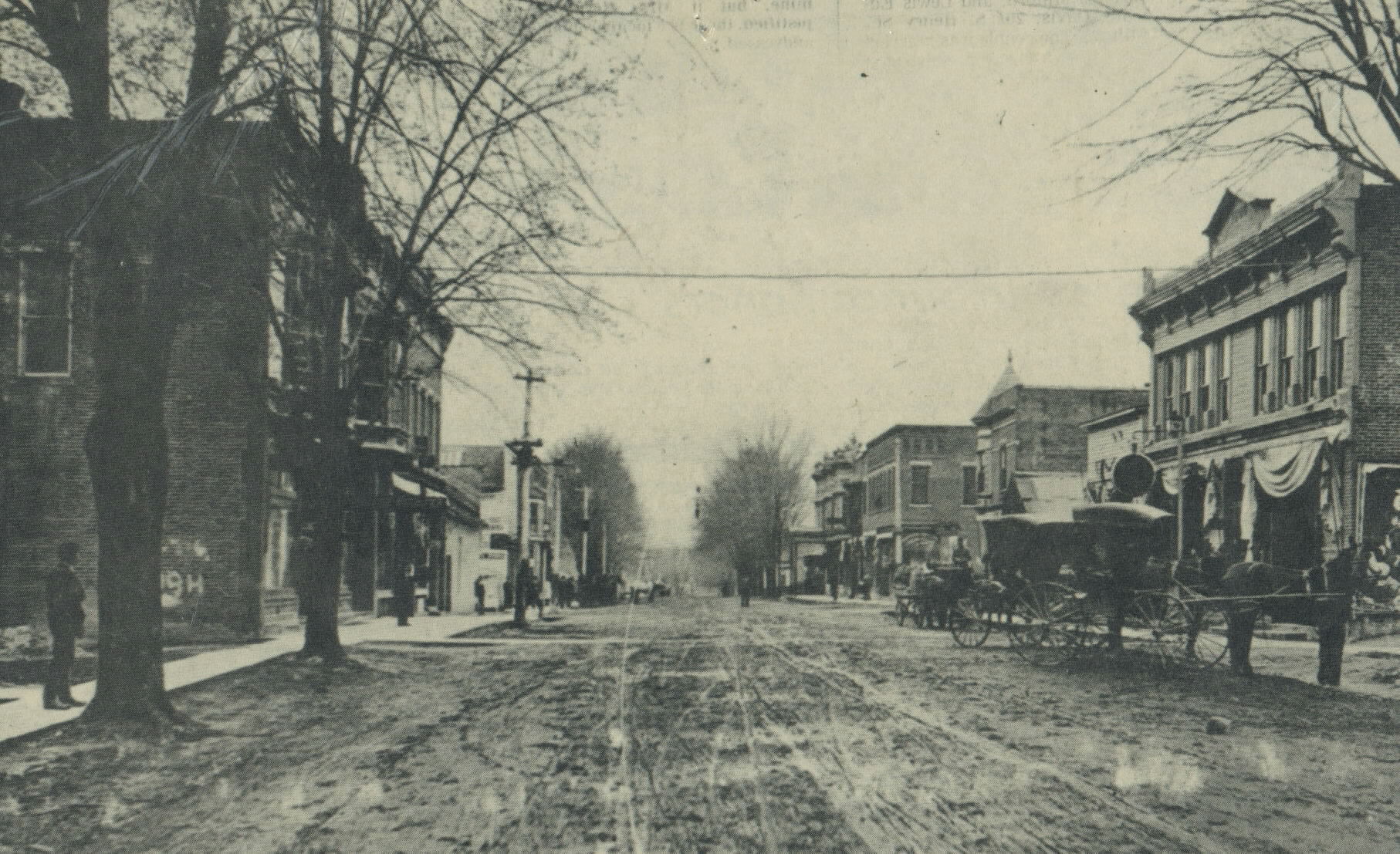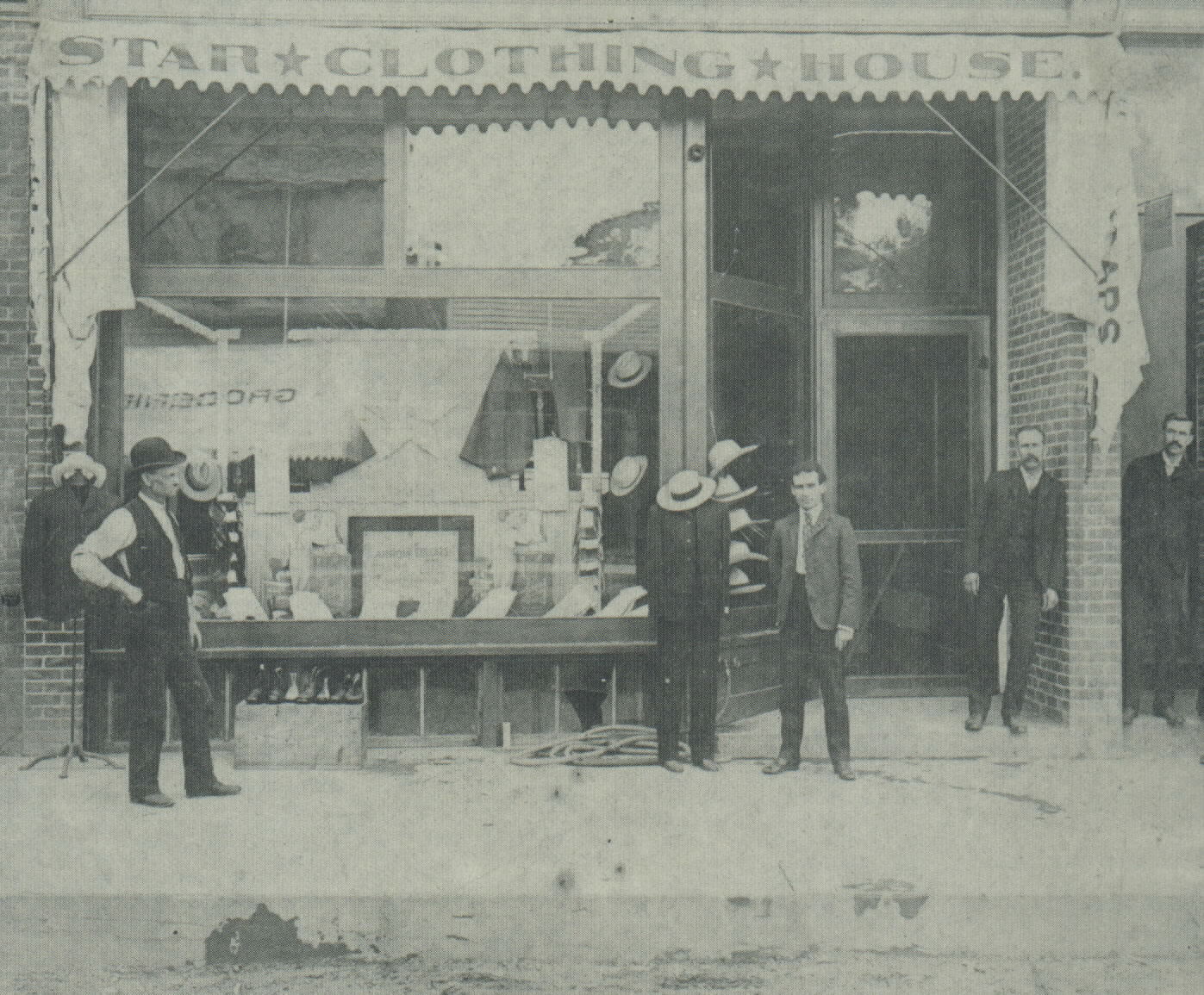Syracuse Historical Bus Tour
Written by Lera Reinholt 2008, updated 2015, 2024
This tour is designed to inform you about Syracuse and its past. Information for this tour has come from books, newspaper articles, historical records, plus information from Ron Sharp, a local historian, and Ken Harkless, a lifelong resident. Hopefully you will enjoy this look at our town.
Site #1 Syracuse Elementary school (Urban Oak Apartment Homes, 502 W. Brooklyn St.) parking lot Many years ago, Turkey Creek ran through the spot where we are parked. In the early 1900’s Turkey Creek was put in the channel it now follows behind the school, and this area was filled in.
The land here was very low and flat. There were a couple of houses in the area. The elementary school at that time was located on what is now the uptown parking lot across from the library.
The very first schools were one room schools located on pieces of land around the township. Some of these brick ones can be seen in the rural areas around Syracuse. Information about schools before 1900 will be given later.
In 1925, the schools in the township consolidated or joined together. Two locations were considered for a new school. The area where Vega Field was (further west on Brooklyn St.) and this site were both considered. The elementary was housed in the 1907 building on the uptown parking lot area. In 1927, a new high school was built where the playground is today on the property where we are now. The front entrance of the 1927 building decorates the side of what was the elementary building.
A cafeteria and multi-purpose room were added in 1954. The multi-purpose room was used for band and music. The uptown elementary building had outgrown its limits so the gymnasium, foyer and the front wing to the north were added to house the elementary grades. The uptown school was torn down in 1955.
Syracuse continued to grow and a wing behind the building was added in 1959 for more elementary rooms. In 1967, a primary wing was added on the north end extending to the east. Students were sad to see the huge shade tree removed that offered a cool place on hot days on the playground. In 1989, a wing was added to connect the ’59 and ’67 wing. This created the outdoor lab, a computer room, new art and music rooms, seven more classrooms, and a larger library. Recess for upper grades had to move to the parking lot.
In the 1990’s schools from North Webster, Milford, Leesburg and Syracuse who were part of Lakeland Community School Corporation discussed combining. This resulted in the formation of the Wawasee Community School Corporation with Leesburg deciding to join Warsaw Schools. It was decided to build the Wawasee High School at its present location and the middle school on highway #13 with Milford maintaining a high school.
When the high school was completed, the old high school building here served as Syracuse Junior High until the new middle school was completed. This old high school was torn down in 1992 and the area cleared to become the playground for the upper elementary grades and area for physical education classes. The new Syracuse Elementary School, 12799 N Kern Rd., opened its doors to students on August 14, 2017.
Site #2 at 302 W. Main
Early deeds indicate that Samuel Crosson and Henry Ward had recorded their claim to this section of town on July 28, 1835. This area was the first area platted and sold.
Reference is made in a deed to Judge Ward’s office (formerly Bob Reed’s law office and home, 205 W. Main St.) and Samuel Crosson’s saw mill and grist mill in this area. This house in this 1904 photo is built like many of the homes around the turn of the century. It is believed that the home was built on an 80-acre farm. When Bill and Vivian Kern moved into the house in 1946, they added an indoor bathroom and remodeled the kitchen and other rooms. No one seems to know how Syracuse got its name. It may be that some of the early settlers had come from Syracuse, New York, or perhaps they knew of the ancient city on a hill on the island of Sicily. Maybe they just liked the name.
Site #3 at 306 N. Main
This two-story structure was originally in the uptown area and is believed to be a sister to the house at 111 E. Main St. (next to the library). The home dates back to the 1840’s. It was common in those days to move homes rather than tear them down.
Site #4 Vega Field (general location of Polywood factory)
This was Syracuse’s first industrial park. The area known as Vega field belonged to Wawasee School Corporation and was used by physical education classes at the elementary school before the Jr. High building was torn down. Little League games were played here until they moved in 1974 to the field at St. Andrews church. Dutchman had five plants in this area. For over 20 years they produced RV Travel trailers and fifth wheels. Image Group was in business beginning in 1969. They specialized in commercial printing, signs, business cards and related work. They employed about 29 workers. A fourth business was Burke’s Seawalls. Polywood transforms recycled milk jugs into plastic lumber used to create casual outdoor furniture. Polywood purchased all of these former business sites and either razed or remodeled the buildings to expand their business. As we go down Boston Street notice the older houses recognized by their field stone foundations.
Site #5 Parking lot of Veteran’s Memorial Park at Crosson Mill, 301-399 N. Huntington St.
In the early 1830’s the first white men came to the area. They found good land, many trees for lumber, wild game, and lakes full of fish. Around 1832, Samuel Crosson and his wife, Nancy, lived here. They had three daughters and one son. Mr. Crosson was described as “a very genial and gentlemanly man” and Mrs. Crosson as “a most worthy woman”.
Soon after arriving, Samuel Crosson and his hired man, Ephriam Davis, built a dam. The dam is thought to have been where the bridge crosses Huntington Street. In 1834, he built a grist mill near where we are now. It was the first mill in Kosciusko County.
The area where Dolan Drive is now was the mill race. This was the water which turned the water wheel that provided power for the mill. The other founder of our town, Henry Ward arrived in 1835 or ‘36 from Massachusetts with his wife, Sarah. Ward earned his living as surveyor and became Crosson’s partner in the mill business. Soon after, spring rains weakened the dam, and it gave way. The mill was destroyed. Another mill was constructed at the far end of Dolan Drive where it meets Main Street. That mill was also destroyed by a flood. The mill stone is said to be at the bottom of the creek.
After the mills were gone, people built houses along the race and used it for swimming. Across the mill race was the Royal Blue Store which sold groceries. The grocery was also known as the Rosenberry Grocery. Kitson’s Plumbing and Heating is in the background with Miriam Byrd standing in front of the store. About 1 ½ million gallons of water leaked out of this race each day. This caused a problem with the lake level. The Town Board of Trustees decided to fill in the race. (Photo# 6 mill race) People who lived along the race were unhappy to lose their swimming hole. Despite objections the race was filled in 1964.
For several years an Indian statue stood here to remind us of the Indians who inhabited the area before white men came. William E. Long was responsible for bringing the statue here. It had been a cigar store Indian in Chicago. Due to weathering and vandalism, it was necessary to remove the Indian. It can now be seen in the lobby of the Community Center outside the Syracuse-Wawasee Historical Museum near Lakeside Park.
A veteran’s memorial has been built here at Crosson Park. You may find it worth your time to take time to visit it sometime. A Farmer’s Market is also held here on Saturday’s during the summer.
The Syracuse area was first inhabited by Potawatomi Indians. On the north side of Syracuse Lake is a historical marker that marks a high land known as Indian Hill. This has been found to be the burial site for the Potawatomi tribe. The Indians placed dead bodies in trees and tied them in place. When the white settlers came, the decayed remains were found and some had fallen to the ground. A number of years ago a complete skeleton was found on Indian Hill and taken to the high school for study. Another legend concerning Indian Hill is that Indian babies were placed in a kind of swing and tied to the tree branches. When a breeze would blow the little babies would be rocked. When the Potawatomi left this area, they went to Illinois. Later the federal government forced them to go to Kansas.
Miami Indians lived in the area around the lakes. They were led by two brothers, Papakeechie (Flat Belly) and Chief Waubee. Chief Waubee originally lived in the Milford area. His name was sometimes spelled W-a-w-a-e-s-e-e. In later years when Eli Lily was looking for a better name for Nine Mile or Turkey Lake, he changed the spelling to W-a-w-a-s-e-e. Chief Wawasee and his people received word in the night from the government that they were to move to Kansas. During the night members of the tribe were seen heading to Michigan. They were never heard from again.
Chief Papakeechie lived in a brick house built for him by the government near Indian Village. When the order for the Indians to leave, it is not known whether he left. One story claims he died and was buried near his home.
This park is named for Samuel Crosson who with Henry Ward founded our town. On the sign here Crosson is spelled C-r-o-s-s-o-n; however, on some of the early deeds it is spelled C-r-a-w-s-o-n. We might explain that this was due to the fact that not many people had a good education in those days.
This area was a junk yard in the 1930’s. The government under President Roosevelt started WPA projects to give unemployed workers a job. Many of these workers helped to make America beautiful. WPA workers filled in this area and made a park.
Mr. William E. Long had become quite wealthy after he invented a bread wrapping and slicing machine. He purchased land on Kale Island and in 1927 erected the beautiful Chinese gardens. These gardens with bridges, flowers and swans attracted many thousands of onlookers. Mr. Long made other contributions to our community. Listen for his name later on in the tour.
The Scout Cabin which stood here was the site for girl and boy scout meetings. It was built in 1950 at a cost of $7000. Senior citizens also met here. The building deteriorated to the point it was not possible to repair it, and it was torn down. The Syracuse-Wawasee Rotary Scout Lodge is located at 10344 N 500 E, Syracuse.
In the late 1800’s trees were cut down around Turkey Lake as the lake was called then. The logs were transported to Crosson’s saw mill which was located down the creek from the grist mill.
Crosson’s first dam was where the bridge is now. Problems came up when people above the dam complained of high water and people below the dam had problems with pigsties and hen houses floating away. A study group laid plans to solve the problem. In 1964 this new dam was built and a memorial made to Eli Lily who helped to finance it. Eli Lily had made his fortune in a drug company in Indianapolis. He had purchased property on Lake Wawasee and was quite interested in the history and development of this community.
Crosson and Ward owned many acres of land in this area. They divided it into lots and named the town Syracuse.
Site#6 Parking area on Huntington Street
This street is called Huntington Street because in the early days it was an important road from Huntington to Goshen. The cleared area just to the south is where a large cement block building stood that was built in the 1928 by McClintock, Cowell and Gordy. They had a cement road building company. When newer methods of building roads developed, they went out of business. Gordy later had a machine to make dry cleaning bags. Later Sea Nymph used the building for manufacturing aluminum boats, and after that Polywood began their business here.
Across the street where the apartments are (on Turkey Creek where it flows under bridge) was the site of Home Store which Everett Ketring built and operated in 1937 selling groceries and other items from the Home Store Company. Later Arnold’s Grocery was in this building. The house to the south had been a filling station, and Ketring made it into a house. The third house to the south was Mayme Long’s Gift Shop (116 N. Huntington St.). She was the wife of W.E. Long. The two houses at 110 and 108 N. Huntington were at one time joined and the home to the Beckman furniture store. Beckman Furniture had earlier been in the Pickwick block.
Looking across Huntington St., several businesses have been in the building where Paul Stoelting’s office is now at 203 N Huntington St. Some of these were Kettering’s Grocery, Wilkinson’s Paint and Wallpaper Store, Aunt Verna’s Restaurant, and Chico’s Restaurant. Next door, Koher Insurance was originally a gas station operated by “Buffo” Rogers. The glassed in area was where the cars drove under to get their gas.
Site #7 Beef’s Booze Barn, 100 N. Huntington St. at the railroad – formerly the Liquor Locker.
In the 1930’s, the Jones Boarding House (Photo# 15) stood where the Beef’s Booze Barn is now. Passengers passing through on the railroad would often stay overnight and engineers would dash over for a cup of coffee. Just before the Liquor Locker was built, a Pure Oil Gas Station was located here.
The park just behind the building to the east has been named Henry Ward Park after Samuel Crosson’s partner in the mill business. Due partly to loca1circumstances and the Panic of 1837, Crosson and Ward found they had many debts and lawsuits. These factors may have contributed to the early deaths of these two men. Samuel Crosson is buried in the Syracuse Cemetery; however no one has been able to find out where Ward was buried. The area was a swamp before the town filled it in. In early days, ice houses were located along the shore here. Huge blocks of ice were cut from the lake and stored in the ice houses for later use. Some was shipped to Chicago.
Across the street is the site of the railroad depot. The Baltimore and Ohio Railroad came through here in 1874. This was real boom to Syracuse since there were not large trucks in those days and all produce and mail came by rail. Dozens and dozens of trains came by. The wooden passenger cars were far from comfortable. The engine coughed and belched smoke. The seats were hard. The only heat in winter came from a coal stove. Open windows were the only means of air conditioning in summer. Smoke and cinders also made the passengers uncomfortable.
The first depot on this site in the 1870’s was a wooden structure. In the early 1900’s there were two large wooden tanks along the tracks east of the station. Water was pumped from Syracuse Lake, treated, and stored in these tanks. Syracuse was a watering stop for steam locomotives.
There was one train that was referred to as the Milkshake. If a farmer would set his milk can along the tracks, The Milkshake would pick it up. This train ran from Garret and arrived each day at 6:00
In the early 1900’s the Sandusky Portland Cement Company was dredging marl from the lakes. The business laid tracks connecting the B and O tracks to a track to Waubee Lake. The line was called the Syracuse and Milford Railway. Marl was dipped from Waubee Lake and Lake Wawasee and transported on the rail line to the Syracuse cement factory. Around 1920 the Sandusky Cement Co closed and the Syracuse Milford Railroad went out of existence.
A B and O Capital Limited took the place of freight trains. The first train stopped in Syracuse in 1874. The brick depot was built in 1916. An attempt was made to save it because of its historical significance, but it was deteriorated so much, it was torn down in 2012.
Across the tracks is the former Vylactos Plant. It was a feed manufacturer. The process made a disagreeable smell. A by-product of the cattle feed was bird blocks. Later the business was sold to PM Ag Products. In the 1940’s Wright’s Grocery was located here. For a short time, Sweet Deals Cleaner Shop used the facility. Currently Track and Channel and Bait and Tackle was located here until it moved to the Village.
In 1836, the area just across the tracks was platted and given the name of Newburg. It is not known why the town did not develop, but John Briggs dream of a new town was abandoned. At this time, the Huntington bridge did not exist. The main route to the uptown area was Boston Street. Taverns were located along the street and brawls were a common occurrence. With the nearest sheriff in Warsaw, it was impossible to keep order.
Diagonally across the street is Patrick Industries Incorporated (203 S. Huntington St.) where they have made AIA countertops since about 2014. In early 1800, a flour mill stood on this site. It made Golden Wedding and Wawasee brand flour. Later it became the Jones Feed Mill and also sold coal and ice. Liberty Coach purchased the property in 1946. Fire destroyed the plant in 1947. The business moved to Bremen. The Syracuse plant was rebuilt in 1957 and by 1958 employed over 700 people in both plants. Liberty Coach was a pioneer in the mobile home industry. They were the first to figure out a heating plant for a mobile home.
There have been several businesses along Railroad Avenue toward Dana. The Advanced Radiator Company was destroyed by fire. In 1921 there was the Syracuse Table Co. which with 15 male employees produced 30 cedar chests a day. Beckman Furniture was an outlet for their product. In 1923 Wawasee Cedar Chest Co. made and shipped cedar chests all over the world. This building was sold in 1928 and became the Stametz Cookie factory. The Oasis Tavern was also in the area.
Located west along the railroad tracks near the Syracuse-Webster Road crossing was the Union Canning Company’s pickle salting station in the area where the large plant built by the Weatherhead Company was located. Eli Lilly assisted the town in raising funds to get Weatherhead here. It opened in 1952 and became one of the county’s largest industries. They produced brass and steel pipe components. Dana acquired the business in 1978 and converted it into Spicer Axle Division. Later it produced transmissions. In 2008, Jasper Plastics Solutions moved into the eastern part of the building. The western one third of the building is Leading Edge Countertops specializing in residential, commercial, and recreational vehicle countertop fabrication.
Site# 8 Wawasee High School
Until 1924, school in Syracuse were managed by a town board. Then authority was transferred to the Turkey Creek Township trustee and his board. In 1958, the Metropolitan School District of Turkey Creek was organized. Then in 1962, Leesburg, Milford, North Webster and Syracuse formed the Lakeland Community School Corporation. Leesburg (Plain township) elected to withdraw to join Warsaw Schools in 1965. The new consolidation became Wawasee School Corporation as it is today. Wawasee High School was built in 1967 at a cost of $3 million.
Site #9 Lakeland Youth Center (300 E. Chicago St.)
The first Lakeland Youth Association met in the Pickwick block in 1964. Funds were raised, and in 1967, this center was built at a cost of $55,000. Wawasee Lumber Company had been located on this site.
The building north of the McClure Station (311 S. Huntington St.) was built as a locker plant. Kleinknight purchased it in 1949 for a car dealership. In 1960 it was purchased by McCormick and Cutter for a Chevrolet dealership. In 1969 Bill Cutter purchased the business and named it Cutter Chevrolet. Dan Wyant bought the business and continued the dealership and for a short time Zollar Ford was in business here. The business was sold to Alan Tehan who sold boats under the name of Precision Marine. North of Cutter’s was the KKK (Kountry Korner Kafe) restaurant The lady who owned it had a mink farm and cleaned chickens for sale in the rear of the building.
Rinker Boat Company was one of the largest independent boat companies in the 1980’s. Losee Rinker started making wooden boats when sons, Jan, John and Jim, were young boys. The Rinkers moved to Syracuse from the Indianapolis area and continued making boats in a small shop as well as racing them. Stover Hire and Bud Hursh who also raced boats are pictured with the Rinkers as they head for a boat race. This shop was located near the creek behind Cutter’s Car Sales building. John Rinker purchased the land where the business is now located on W. Chicago St. and began making fiberglass boats which were replacing wood boats. The company was sold in 2005 and is now run by new owners.
Site #10 (The Gift Shop at Wawasee, 507 S. Huntington St.); Businesses on west side of SR#13 south: South of the Lakeland Youth Center is Horizon Bank, then the drive-in which was A and W Root Beer before Shopoff changed the name. It is now under new ownership. Barry Miller purchased the next property and now has a plumbing heating business as well as Miller Gun Sales in the building. Compton Automotive (used to be G and L Quick Lube, is the drive to access the Quick Clean Car Wash which was built in the 1960’s by Paul Gerke and Bud Felkner. In 1975 the business was sold to Carl J. and Lera Reinholt and the name changed to Syracuse Car Wash. Due to vandalism the business closed in 1987, and Sam Markley purchased the building to make wood crafts. The front drive was sold to G and L Quick Lube in 1999). On the corner is Momo’s Pizzeria.
In the next “block,” the corner building (The Gift Shop at Wawasee) was occupied by Bevis Hill in the 1960’s who operated a laundry and dry-cleaning service, formerly the location of Clarence Ruch’s Lawn and Garden Shop. Absolutely Apparel and Gifts is on the NW corner of SR 13 and Maple Grove St. (In the past it has housed Elder’s Realty Office, later an electronic business and a couple of print shops, then Sue’s Creation’s.) Several businesses were in the building on the back half of the lot. Peggy Halsey operated a beauty shop there and for a brief time a tattoo parlor rented the space.
Going on south from the SW corner of Maple Grove St. and SR#13: Pat’s Chicago Dogs, Brew City (at one time Wawasee Flash Photo – a one-hour photo store), H and R Block, Picket Fences hair salon, El Pacifico to the corner across from Dairy Queen.
On the east side of SR #13 going south is Lake City Auto (NE corner of E. Baltimore St. and SR#13). This was formerly a Sunoco Gas station owned by Jack Spitler. On the corner where Penguin Point was (SE corner of intersection), there was another Sunoco Station owned by Don Rumfeldt. It was unusual that two Sunoco Stations were located in Syracuse so close together. The station was torn down, and a Kentucky Fried Chicken business was built there. Later Penguin Point purchased the property, but later went out of business.
What is now Wilby’s (NE corner of SR#13 and E. Pittsburgh St.) was formerly a Standard Station owned by CD Lawson Later it became Amoco. A Laundromat owned by Rodney and Frances Koontz was located where Remax is now (SE corner of the intersection). CD Lawson purchased it later. Next to it was a Dog and Suds owned by Art Skedas, a liquor locker and Tom Stiver’s Realty Office, and Martha Stoelting’s Village Florist Site (Photo #91) Where CVS is (NE corner of SR#13 and E. Chicago St.) was a Texaco Gas Station owned by Dave Egolf. Later Tim Wilson operated a Marathon Station there before it became a ready mart. Behind the ready mart was Barb Markley’s Crafts and Kenny Felt’s Neon Signs.
Across Chicago St. was the site of Klink’s Grocery (SE corner of SR#13 and E. Chicago St.).
Klink’s Grocery was on the north end; Bernice Klink’s Beauty Parlor, Logan Roger’s Real Estate and Thornburg’s Drugstore occupied the remainder of the building. Later Pilcher’s Shoes was located in the Klink Grocery building before moving to North Webster. Other businesses that have occupied the building were Taco Bell, Coffee Depot, New China Buffet, and B C Tile and Flooring. Culinary Teas at one time occupied the B C Tile space. Kiyomi Japanese restaurant, Anchor Down Tattoo Co., and Kraft Auction Service currently (2024) occupy the space. Crossroads Bank is just south of there, next to Lake City Bank, neighbor of Bales Butcher Shop.
In 1952 Wawasee Village Hardware was built where Bales Butcher Shop is now (NE corner of Maple Grove St. and SR#13). The back part of the building was an upholstery shop. Napa and Joy’s Auto Parts were in the building before Darrell Bales moved his Butcher Shop from uptown in 1989.
Across Maple Grove St. on the SE corner, Metz Auto and Outdoors was the location of The Wawasee Harbor Yachts where the Country Mouse business was located; Joyce Smith sold clothing. The Country Mouse building was originally built by Rollie Byland as a bait shop. Behind the Country Mouse was the Wawasee Village Barber Shop. L Gaff operated the business before it was purchased by Ed Harding. He had been barbering in Huntington before coming here. The next building (Loveless Pier Shop) south of the Country Mouse was originally a furniture store before Marise’s Town and Lake Shop and Tom Socks opened clothing stores. The corner business was the Anchor Man, and later Clem Lisor built the Sportsman Center which was torn down to make way for a bank which is now Appleseed Eye Care.
Across the highway on the NW corner of W. Pickwick and SR#13 was the site of Lakeside Bakery built in 1955 owned by Joe and Howard Stametz. It was the first business in what was is now El Pacifico restaurant, previously Wawasee Café – a retail bakery with a coffee bar, sandwiches and breakfast menu. Kelly England purchased the business in 1978 and named it England’s; changed by later owners to Wawasee Cafe.
Site #11 Neighborhood Fresh parking lot
The Dairy Queen located at the SE corner of SR#13 and Pickwick Road opened in 1953. It has changed some as different owners have made improvements. A Burger Dairy Store was located behind the Dairy Queen where there is now a drive and advertising sign for the Wawasee Boat Company. Bales Butcher Shop was also located here for a short time. Wawasee Trading Post and Touch of an Angel gift store was next to the Dairy Queen. A hair salon and nutrition store are perhaps located there now.
In 1973, Ben Franklin and Hooks Drugs were built in the small shopping area beyond the Burger Dairy Store. Hook’s sold out to CVS who operated out of this building until they moved to their present location north of here. The Ben Franklin building became Family Dollar and is currently Track and Channel Outdoors. The Hook’s part has housed Wawasee Newstand, a fireworks store and an A.T. and T retail store. A smoke shop and seasonal fireworks shop occupies the space now (2024).
On the west side of SR#13, south of Pickwick Drive, Lakeside Laundry and Wawasee Motel were razed to make way for Arthur’s Grocery of the Marsh Supermarket chain. It was closed after only a few years of operation. The Lutheran Health Physicians now occupies the north end of the building. The rest of the building houses a Verizon store. Los Toritos currently is located in the old Duffy’s Pub and Grub which was the former location of Foo and Faye’s Chinese restaurant which opened in 1954 and was extremely popular. Pizza King was built on the site of the Country Corner Gift Shop which was built by Fred Elstrod in the 50’s as an antique store. His wife ran the business and later added gifts. It was the first commercial building built by Ray Buhrt. Up to that time, Ray had only built homes. Locals thought they were insane to build in such an undeveloped area. Jennifer Seward purchased the site and operated Country Corner from 1974-1999. The Foo and Faye Restaurant was built as Buhrt’s second commercial project.
As late as 1940, Highway 13 did not go through the Village. The area was a swamp which has slowly been filled in. This has destroyed the habitat for deer and has contributed to the problem of deer in business and residential areas. As you go through the Village you will notice that some businesses like McDonald’s are quite high while others are low and dealing with water problems depending on how much fill went into an area. The building that seasonally houses a fireworks store was formerly Wawasee Billiards As you can see in the photo, this business lot has not been filled in with dirt and still deals with the problem of flooding. Next to it is Grill-N-Grate BBQ which sold to Peterson’s Fish and now (2024) is a smoke shop. Peterson’s had been operating out of South Shore. At one time they were located where the landscaped area is beside Pro Wake Watersports (1309 S. Harkless Dr.). They were known as Gropp’s and later Pete’s Fish. Pro Wake Watersports is located in the building built by Lakeside Fitness. Owen Cobbum went into the tire repair business on that lot and later expanded to boat repair and sales.
Site #12 The United Brethren and Evangelical churches merged in 1951. The combined congregations elected to build this church in 1958 at a cost of $250,000. The bells from the Lakeside United Brethren and the Trinity Evangelical church were hung in the new church, and they rang to summon the congregation in October 1961.
John Augsburger built the current Neighborhood Fresh Market (formerly Lance’s Market) in 1962 at a cost of $275,000. Augsburger served as senator to the Indiana Legislature. The current Dollar General was Teghtmeyer Ace Hardware before they moved to their present location further south on SR#13. FitStop (formerly Video Limited) and the China Star Restaurant are on the former site of the Mary Ann Drive-in. In 1972 Peter Pang purchased the facility and featured Chinese food. Currently (2024) a Napa Auto Parts store is the next business going south.
The Three Flags Restaurant was built by Kenneth Gragg of Warsaw. Jack Oswald purchased it in 1975 and remodeled it. It was a very popular meeting place especially after high school athletic events. The restaurant was torn down to build the current Cape Cod style blue-grey building (800 S. Huntington St.) which was Doc Miller’s Fish and Seafood Co., a wholesale distributor for fish with a small restaurant. Various businesses have been housed in this building, among them Old Whaler Antiques and More with My Red Moon Antiques and Collectibles there now (2024).
Going south, the Subway Restaurant building was built by Sherrie and Oris Schaeffer in 1974 and called Village Green Lawn and Garden. Subway added a kitchen, changed the front and redecorated the interior for the present restaurant. Rich Beauty Parlor (formerly the Northern Lakes Family Medical Center) was originally built by Peewee Sellers for the Ivy Hut Floral Shop which his wife operated. In 1980 the business was sold to Carl J. and Lera Reinholt.
They converted the business to the Ivy Hut Restaurant. In 1987, several doctors purchased the property and created the medical center. The adjacent property to the south had been a car lot and parking lot before in 1988 Kratzer built the storage units and a gift shop for his wife. This was the Brown Bag Deli and later Forte Home Health Care. It is now Znergy lighting contractor. The furniture store was built by John and Nancy Glon. An entrance on the south side led to Kathy McKibbin’s Beauty Shop. The new owners of Living Quarters specialize in outdoor furniture. Going on towards the corner of SR#13 and Palm Drive is an empty lot, the former Chalet Realty building and Key Bank.
Site # 13 – Steffen Realty parking lot (1416 S. Huntington St.) The building which houses American Legion Post #223 was originally a skating rink. Wood from the Sargeant Hotel was used in its construction. A furniture store occupied the building until it was sold to the Legion. North of the building, where the cleared area is, was the site of a block building built by Seiffert Tile in the 1950’s. Hire Electric occupied the building before it was sold to Jan Rinker. He and Mike Smith opened a business called Multi Products where they made small fiberglass boats and pedal cars. The property was purchased by the Legion and the building was torn down.
To the south, across E. Lynwood Dr., Dockside Gifts and Apparel occupies the building which housed Darlene Lung Fetters’ Clippers beauty shop. It was built by Ray Buhrt in 1958 and was Bill Lung’s Cabinet Shop. Buhrt Builders are located in the adjoining building. Lakeland Schools had administrative offices there before new offices were built on the Wawasee High School campus. Buildings further south are Indiana Farm Bureau Insurance and Pizza Hut.
The building behind Dockside Gifts and Apparel is Hunnicutt Hanger. Before SR#13 went through this area, Rue Hunnicutt had an airplane which he took people rides in on Sundays for a small fee. He also operated a small amusement park with a ferris wheel, merry-go-round, motorcycle track, golf course, and go cart track. He even had a bear, monkey, donkey and deer. The large house beyond the apartments that looks like a barn was the barn for Hunnicutt’s horses. The amusement park closed in 1956.
Site #14 – Wawasee Bowl (1199 S. Huntington St./SW corner of SR#13 and Bowser Road). The first bowling alley in Syracuse was located in the Holton House where the theater is today. A later one was located in the basement of the Pickwick Block. Joe Morgenthaler built Wawasee Bowl in 1967 at a cost of $300,000. Susie and Jack Kern operated the bowling alley until 1980.
Across Bowser Road, the area where Burger King is now was formerly the site of a ready-mix business. Later a restaurant called The Red Door Inn was built. The next owners changed the name to Cocinero’s and added a dance hall to the west with live bands. When the restaurant was torn down, considerable amounts of fill were brought in to raise it to the level it is now.
As we travel east off SR#13 on Bowser Road towards Oakwood Park, there is a small log house to your left. This building was used by Hunnicutt as a home, office and restaurant. The outside has been restored.
Site #15 – Oakwood Park at the parking area in front of the sand hill.
Oakwood Park is located on 40 acres of land that was originally known as Conkling’s Hill. The name Oakwood was arrived at due to the large amount of oak wood growing in the area. Bill Conkling and his wife lived here well before 1844. On April 9, 1892, the Indiana Conference of the Evangelical Association purchased the land as a permanent camp meeting ground. Conkling’s Hill was purchased for $5000.
This area was a huge sand hill. Sand from this area was used to fill in the area around Oakwood Hotel and the low area around Highway 13 in the village area. Camp Oaks (Photo #43 cabins) was located on top of this hill. The first of the seven cabins with bunks were built in 1931. The camp experienced much growth and a lodge was added in 1949. This log and brick lodge housed a camp office, first aid room, leader’s quarters, assembly room with a fireplace at each end, and a bunk area with twenty bunks. The first hotel was also on this hill where the new building is now.
It was a frame building built in 1875. Resorters who came in on the B and O Railroad stayed here. Transportation was available to the park by “hack”. When the church bought the property, the hotel was used as the “superintendent’s” home for a number of years until it was torn down in 1931.
Site #16 At the center parking lot of Oakwood Park. To our left is Kimmell Hall which was built in 1924. Camp classes were held here. The lower rooms were originally open. The first camp meeting was under a large tent tabernacle here on the hillside in 1893. In 1896, a powerful windstorm tore down the tent tabernacle and many smaller tents used for housing. In 1898, a frame 60×90 tabernacle was built at a cost of $1500. Donations of funds and labor of ministers were responsible for covering the cost. In 1914, 16 years after construction, the building was destroyed by fire. Immediately in 1914, an octagonal tabernacle was built at a cost of $5000. This building had a dirt flour, open studs and a large stage. A large bell near the tabernacle called campers to meetings. In 1960, the tabernacle was torn down to be replaced by the new program center which provided additional classroom, meeting, and auditorium space.
The chapel was a miniature of the large tabernacle and built as a children’s chapel. The interior had open studs and chairs for seating.
As years went by, attendance grew, buildings were built and roads were paved.
The first youth camp, Camp Oaks, began in 1926. From 1959-1979, Chinese camps were held here. The purpose was to assist Chinese students who are studying or employed in the United States in solving their personal problems and to live more satisfying and fruitful lives. The last Chinese camp was held in 1990. Various week-long camps for training Sunday School teachers were also held here.
Site #17 – Parking lot in front of the hotel – looking toward the hotel.
There was originally an island where the first two cottages are located to our left. A lovely lagoon, rustic bridges, and channels were where the parking lot is. ) Boats could come up to the cottages on the west edge of the parking lot. The steamboat in this picture would deliver people from across the lake for 10 cents.
The second home on the lake is the location of the island owned by W. J. Fredericks who owned Conklin Hill and negotiated to sell this area to the church. Sand and gravel from the hill was used to fill this in. The location of this hotel was known as “Duck Point” before building began here.
The first hotel was a block structure built in 1904-1905 and was called Esther Hotel. It was named after the superintendent’s wife. In the photo you can see two cottages on the left which were moved to build the second hotel.
The next hotel was built in 1927. In 1946, the Evangelical church combined with the United Brethren. This area continued to be the campground and conference center for the Indiana North Conference of the new denomination. In 1986, Oakwood Park became one of five campgrounds of the newly formed North Conference of the United Methodist Church. Several ministers who served in this area were ordained at Oakwood. These were Richard Bunnell, Ross Cook, James Hook, Kenneth Overmeyer, and Kennard Robinson.
Boat-in Worship has been a regular event at Oakwood since 1969. Interdenominational services are held every Sunday from 8:30-9:00am, Memorial Day through Labor Day. Attendees arrive by boat or gather on the lawn on blankets or in their own lawn chairs. Some even join the service on board the SS Lillypad II (docked behind the Frog Tavern; arrive by 7:30 a.m.). In 1995, Paul Harvey called attention to the event on his radio program.
Site #18 – Oakwood Park Orchard
The park superintendent in 1931 was responsible for the planting of 500 apple trees in this orchard. The orchard came to produce a much-needed source of income for the park. The orchard was known far and wide as producing splendid apples.
Site #19 – (816 S. Harkless Dr.) NE corner of intersection with E. Palm Drive
The property on this corner belonged to Elmer Stucky who built this two-story house. Stucky’s daughter, Gwen Immel, lived here until her death in 2002. Stucky build a furniture store on the lot north of the house. In 1948 the furniture business was moved to beside Syracuse Hardware and later to where Love Furniture was located (now The Revolving Closet) on Huntington St. The building on S. Harkless Dr. was sold to Gaylord Jones who operated a hatchery here. They raised chickens and turkeys for wholesale and retail sales as well as sold feed. Several chicken houses were built behind the main building. The Jones family lived in an apartment above the plant. In 1950, a fire damaged the business in an amount of $18,000 and the family had to temporarily live in a trailer. It was later completely destroyed by fire.
An A and W drive-in was located off E. Pickwick Dr. at the bridge where the Channel Marker is now. Main Channel Marina is located on the other side of the channel. The building burned mid-November, 2024, but plans are to rebuild.
Going north on Harkless Dr., Shorty Searfoss’ gas station was located at the SE corner of Pickwick Rd. and old SR13 (Harkless Dr.) directly across from where Miller’s Merry Manor is now at the NE corner. Marsh Harbor Condominiums have boat docks on the bay. Just before the road bends, on the right, Turtle Bay Mobile Home Park was a miniature golf course prior to trailers being located here.
Site #20 – Former Sea Nymph parking lot on Chicago Avenue
Jerry Herbison purchased the old McClintic, Colwell, Gordy building near the dam and in 1946, manufactured aluminum boats and canoes under the name of Herbison’s Aero Boat Company. The business built this new plant on Chicago Avenue which made boats here under the name of Sea Nymph. In 2017, in the old factory building, Polar Kraft manufactured aluminum boats used for hunting and fishing. Polar Kraft shut down its Syracuse operations in early 2024, and the 200,000 sq. ft. building was by Shore Capital of Elkhart County and will be remodeled.
Across from the shipping docks is a small cement block building. At one time Nelson Felts manufactured cement blocks here.
The next business to the north, American Industries, was built in 1946. The firm manufactured paneling. Later owners converted the business to a regular lumber yard which sold building supplies. There are conflicting reports about a pickle factory being here or west of Huntington St.
Site #21 – Boat Launch – Henry Ward Park parking lot on E. Medusa Street
This area was a swamp that has been filled in. In the early days before refrigeration ice houses were along the shore north of here. Huge blocks of ice were cut from the lake and stored in the ice houses for later use. Some of it was shipped by railroad to Chicago.
Before the dam was built on Turkey Creek, Lake Wawasee and Syracuse Lake were just one big lake. It was called Turkey Lake or Nine Mile Lake. After the dam was built two lakes formed. The largest lake that was formed is now the largest natural lake in the state of Indiana. When Col. Eli Lilly was looking for a better name for the lake, he decided to call it Wawasee after Chief Waube (Wawasee).
Turkey Creek flows west to the Elkhart River. Rivers and lakes south of the Continental Divide, which is between Syracuse and North Webster, flow south to the Mississippi River. Rivers north of the divide flow to Lake Michigan. If you were to put a small boat in Turkey Creek, it would end up in Lake Michigan if nothing stopped it on the way. The dam also backed up water to make this small pond.
For many years there was a steel bridge here. It was sometimes called the Hunky Bridge because of the Hungarian workers who once lived near here. Since the steel bridge was too low to allow boats to pass under, this new bridge was built.
Looking east, in the 1950’s a business was located on the Syracuse Lake Condominiums’ parking lot area that manufactured Blue Bell blue jeans.
Where the condos are now was the location of the Hunky House (photo #56). This building housed Hungarian workers who worked in the Sandusky Cement Plant which was located east toward the lake. Because these workers were cheap labor, they were not liked. At one time a bomb was set off on the porch. No one was injured, but it frightened the workers enough to leave town. Just east of the Hunky House was a large cement block building that was part of the Sandusky Plant complex.
Later Wilt Industries manufactured small novelties here (Photo #57). In 1952, the name became Syracuse Enterprises. They manufactured cots, camp stools, crutches and other items. The plant employed mostly women and closed in the 1980’s.
Site #22 Further along E. Medusa Street
The Sandusky Portland Cement Plant was constructed here in 1888 to 1890. For a period of 18 years, the Medusa Cement Company, as is sometimes called, employed over 200 people. The plant made cement from marl it dredged from Lake Wawasee and Waubee Lake near Milford. The Syracuse and Milford Railway Company, the “Mud Line” (no longer in existence) brought the marl from Waubee Lake, touching Conklin Bay, Lake Wawasee, at the marl Slip and on to Syracuse.
One of the oldtimers of Syracuse recalls that the plant was dirty and smelly. The marl ran out and there were complaints that the dredging would destroy the natural beauty of the lake. A state law was passed (applicable only to Lake Wawasee) prohibiting the removal of marl from lakes. The plant closed in 1919, and most of the buildings were torn down by 1922.
The gigantic cement structures that formed the foundation of these buildings were hard to destroy. When housing developers wanted to clear this land, they used dynamite to break up the pieces. A few still remained until lately. Some land owners used them as part of the landscaping around their homes. The street leading to this area is called Medusa after this large cement company that is part of our past.
Site #23 – 108 Front Street
The Fish and Fun Resort was located just south of this house in the 80’s and 90’s. It was owned by Ed Bogart. These cabins were moved here from the north side of the channel on Syracuse Lake east of the Huntington Street bridge. Beckman owned the cabins and had rented them in the l940’s. Alva Nicolai moved the cabins to the Fish and Fun site where he remodeled and rented them for years. In the 70’s the cabins were sold to Lou Kuilema. Later the property was sold to Ralph and Judy Rosekranz and then to Bogart.
This house at 108 Front Street was once the Bowersox home. It was the home of our only movie star. His name was Charles Bowers, and he acted in silent films opposite stars like Mary Pickford. When talking movies came in, Mr. Bowers found that his voice was not good enough for talking films. He was without a job. In the 1930’s, he returned to Syracuse and acted in theaters in the area. This life was not as fine as he had known in Hollywood. He became depressed and decided to return to Hollywood. Shortly thereafter he drowned in the ocean. It may have been an accident, but some believe it may have been suicide.
Site #24 – at 124 Front Street.
This is one of the oldest landmarks in Syracuse. It was built around 1853 on the northeast corner of Main and Huntington. Jacob Renfro built the structure as a hotel. It was in business as a hotel for about 40 years from 1856-1896 at that site. It was moved to this location and is now referred to as Lake House; however, at one time it was called Fremont House after a vice-president of the United States.
Ken Harkless, early resident of Syracuse, explained that in early days many buildings were moved rather than being torn down. He recalls seeing many buildings rolled to a new location. It was less expensive in those days to move a building and renovate it rather that to build a completely new structure.
The curbs and gutters along this street were placed here in the 1930’s under a WPA project. This was a government program that gave work to many who could not find work. This street was also the first blacktop in Syracuse. The area has always been mostly homes.
Site #25 – at 404 Front Street
This house was once an ice cream factory. Since there was no refrigeration in the 1930’s, ice from the lake in winter was used to make ice cream. Ice houses were located on the lake in front of this house to store the ice. The ice was also used to cool meat and other foods. Josie Snavely sold a hand packed quart of ice cream for 10 cents. The ice cream was served at a local drug store in an ice cream parlor with small wire tables and spindly chairs. A glass of cold water came with every ice cream soda. When refrigeration came in during the 40’s, the ice cream factory closed.
Site #26 – 605 North Lake Street
This stone House is constructed of irregular field stone and mortar. It was built in Mr. and Mrs. Merton Meredith lived here at one time. She was a beloved second grade teacher.
Site #27 – at 700 North Lake Street
This lovely home sits on the site of the former Lakeside United Brethren in Christ Church. In 1946, the United Brethren and Evangelical Church combined to form the Evangelical United Brethren denomination. Under the leadership of Rev. Ken Robinson these two local congregations purchased land on Highway #13 to build a new church. The church name became Calvary Evangelical United Brethren. The bells from the two original churches were placed in the new church tower. The church rented spaces in boat houses along the shore.
Site #28 – At 300 E. Main Street
The machine shop was torn down in 1950’s, and Sheldon’s son, Ken, built the house that is here today. Ken lived in this house until his death in 1987. Ken owned and operated what is now the Wawasee Boat Company owned by Doug and Carolyn Anderson. After Ken retired from the marine business, he began to develop his interest in painting and drawing.
He took instruction and began copying faint photographs that belonged to his father. Many of his paintings may be found in homes of residents of Syracuse as well as in businesses and at the museum. Because Mr. Harkless lived out his entire life in Syracuse, he was very interested in community affairs and its history. Since Mr. and Mrs. Harkless had no children, they left most of their estate to the town of Syracuse. Mr. Harkless had attended the high school that was located on the uptown parking lot, and he financed the marker you see there.
Site #29 – At the Community Center parking lot.
This area was once a huge hill. (Photo #63 dump) The park was a swamp and junk yard. Early residents recall that rats made it scary. Boys however found it amusing to shoot or throw rocks at them. In the 1930’s some of the land here was used to fill in the park.
The road past the park is named Long Drive after W.E. Long. Long owned the Chinese Gardens and donated the Indian that stood in Crosson Park. It was his idea to plant the beautiful magnolia trees that line the street by the park. They are a lovely sight every spring. Later we will find Mr. Long was involved in other beautification projects in Syracuse.
In 1937 an Indian pageant was held in Syracuse to celebrate the 100th anniversary of the granting of land to the white settlers by the Indians. The marker here in Lakeside Park was placed at a special dedication. Governor Clifford Townsend and W.E. Long were present at this ceremony.
You will notice that the gazebo has been named in honor of Lela and Ken Harkless. Ken was the owner of Wawasee Boat Company now owned by Doug and Carolyn Anderson. Because of his engineering skill, Ken built the huge buildings at the marina that were construction-wise quite advanced for the time they were built. Both Ken and Lela were interested in preserving our past and left most of their estate to the town of Syracuse. The gazebo is used for weddings, outdoor concerts and other entertainment.
Site #31 – St. Andrew’s United Methodist Church, 1413 N. Long Dr.
The history of Methodism in Syracuse began in April 1870, when Rev. William Graham organized a small class of seven members into the Methodist Episcopal Church. He also served the Milford Methodist church, and the two places were known as the Milford circuit. The Church of God had the only building in Syracuse that could also be used by other organizations, so this is where the little congregation met for several years until plans were finalized for their own church. In 1886, ground breaking took place for the new church on the corner of Pearl and Harrison Streets, which we will visit later. By 1954 the church had been remodeled twice and had become overcrowded. In 1955, William T. Jones organized a survey committee which studied and recommended this location for a new church. Work proceeded to finalize plans for this building which was completed in 1962. 365 people filled the sanctuary for the first service conducted by Rev. Ross Richey. The farm house that stood here is the house just to the north across the County Line Road. Local historian Ron Sharp was born in that house. Ralph Thornburg, Jr. headed a parsonage committee to build the parsonage across the street in 1964.
The union of the Methodist and Evangelical United Brethren churches took place in 1968. In that year the congregation voted to change the name of the church to St. Andrew’s United Methodist Church. Syracuse Rotary leased the land from St. Andrew’s for Little League in July 1965.
Across highway North Indiana Avenue (SR#13) is QES (Quality Engineered Services, an electrical parts manufacturer). This building was built in 1988 by Fisher’s Big Wheel. Pamida was here until 2012, followed by Shopko. Across the entry road, the offices of Syracuse Family Practice moved to its present location from the office complex next to the Methodist Thrift Shop. In 2012 the facility was expanded.
Site #32 – Upper Parking lot across from the Church of God
This is the oldest church in Syracuse. In 1863, the thriving community of Syracuse had a population of around 300 people. Elder George Thomas came to Syracuse to start a church. After just 6 weeks protracted meeting, the result was 40 conversions and baptisms. By 1866, this house of worship was erected. The cost of the construction was $3000. The land was donated by Joseph Defrees who made a stipulation that all Orthodox denominations of Christians shall be permitted to worship here.
A plan was devised to share the cost of operation with Methodists, United Brethren, Lutheran and Dunkards until they could erect their own houses of worship. A Union Sunday School was held with all denominations participating until the other churches were built. Classrooms were added on the east in 1917, a basement with a kitchen and more classrooms was added in 1951, and the 1917 addition was replaced by the brick educational wing in 1973.
A plan was devised to share the cost of operation with Methodists, United Brethren, Lutheran and Dunkards until they could erect their own houses of worship. A Union Sunday School was held with all denominations participating until the other churches were built. Classrooms were added on the east in 1917, a basement with a kitchen and more classrooms was added in 1951, and the 1917 addition was replaced by the brick educational wing in 1973.
Site #33 – Lower parking lot
The first three schools in Syracuse were thought to be log cabins. One was one block south of the stop light where Syracuse Cafe is located. Another was near the Church of God site. Samuel Crosson’s daughter, Jane, operated the school. The third school was thought to have been where the United Telephone parking lot is now. A frame building was constructed on this site and served to educate the community’s children until 1874.
In 1874, a new brick school (upper parking lot on E. Main St.) replaced the frame building. Joseph P. Dolan was the principal for 18 years. By 1907 Syracuse had outgrown its classroom space. A new school was built on the lower part of the parking lot in front of the 1874 structure. A new high school was built in 1927 on the Brooklyn Street site, but the uptown school continued to be the elementary school until 1955. Ken Harkless attended this school and is responsible for the marker in front of the site.
A Baptist church was built in 1847. It was the second house east of the filling station on the comer (formerly Auer’s).
Across Main Street is the Syracuse Public Library. The library was organized in 1908 and was housed in the east room of the basement of the school. The first librarian was paid $125 a year. Most of the books were donations. Hours were limited to afternoon and early evenings, three days a week. In 1916, the library board decided to investigate the possibility of securing funds from the Andrew Carnegie Foundation. Andrew Carnegie had made a fortune in the steel industry and was interested in establishing libraries. A grant was received from the foundation for $10,000. Local funds were raised to cover the remainder of the cost. (Photo #67 First library) The building was dedicated in 1921. Renovation of the library began in 1990 and a dedication took place in 1991 when the project was completed. The cost was one million dollars. The Syracuse-Wawasee Historical Museum was housed on the second floor until the Syracuse Community Center was built, and the museum was moved to its present site. There is a meeting room in the library basement, a computerized system of cataloging books, and computers available for patron use.
The two-story structure west of the library (Photo #68 First Charter) sits on land which was part of the Crosson/Ward tract purchased in 1835. In 1845, the lot was bought by Andrew Wood at a sheriff’s sale. Wood sold the lot to Martin Hilabold in 1849. Shortly, he hired Joe Hendrickson to build this house in what was called the “Greek Revival” style. Around 1900 someone ran a nursing home here. Some years later the building was moved back six feet and made into the Gafill Oil station. (Photo #69 Gafill Oil) In the 1950’s, Bart Cox had a printing shop here. Later the license branch was housed here. The building became decrepit and was put up for sale. The bank purchased the property in 1972 with a plan to tear it down.
Upon discovering the walnut floor joists and poplar siding, it was decided to restore it to its former charm and dignity. It was moved back to its originals foundation and restored as you see it now. The picket fence adds to the 19th century charm. Bass Audiology is located there now (2024).
Site #34 – at 201 E. Pearl – Grandma House. This is one of the oldest homes in Syracuse and is located on what was the original Crosson and Ward plat. The house was moved here from across from the Church of God. In 1861, Evan Miles and his wife Katherine occupied the house with their nine children.
There was one central living room, one bedroom and a lean to on the east side which served as the kitchen. Evan replaced the lean to with a large kitchen and two bedrooms on the west end. He also added a cellar. Bedrooms were added upstairs later to make it the two-story structure you see today. In the photo is Edwin Forrest Holloway and his wife “Grandma” Barbara Ellen after whom the house received its name, The Grandma House. Across the street is the site of the Methodist Church, which later became St. Andrew’s. By 1994, the church was overcrowded and moved to the new location north on SR #13.
Site #35 – at 201 E. Carroll This is the location of the first hotel in Syracuse. James Hall purchased the house from Samuel Crosson and converted it into a hotel. It was referred to as the “Rough and Ready House”.
Site#36 – 501 N. Harrison (one block south)
This is the site of the Trinity Evangelical Church, NE corner of Benton and Harrison Streets church. (Photo #72) The building is over 100 years old and converted into residences.
Site #37 – Corner of Carroll and Huntington
The business on the SE corner was once the Hyde Gas Station. When Mr. Van Lue purchased the business, he added a Radio Shack business before he moved to a location next to McDonalds and back again to this location.
Across the street at the NW corner is the Compass Thrift Store. This building was previously a Sinclair Gas Station. The original United Methodist thrift shop opened its doors in 1962. It continues to be operated by volunteer church women. The shop is stocked entirely with donated clothes and small household items.
Next to the Thrift Store is another of the old houses in Syracuse built in the Greek Revival style. This is the same style as Lake House and the house next to the library. This house was built around 1850. Notice the field stone and mortar foundation. You can identify the older houses in Syracuse by the foundation. Later houses have block or cement foundations.
Site #38 – Corner of Pearl and Huntington. Earlier we related that an early school was located on the site of the Syracuse Cafe. The brick building across Pearl Street, north of the café, served as the post office until the new office was built north on SR#13. The building just north of the drycleaners was built by William Jones. Several offices were in the building including Dr. Wendell Shank, eye doctor. One inventor had an office there as well as a room in the basement. A red light at the door indicated no one was allowed. He later moved to an office south of town where he used his “invention” to assess an individual’s health. After a time the man disappeared. Evidently the invention was not all that successful.
On the north west corner is where Ganshorn Printers was originally located. They moved to the Village where Wooding Tire and Auto (formerly Monteith) is now and eventually located in the Industrial Park under the name Image Group before going out of business. This location was incorporated into 700 N. Huntington St. when it was remodeled c. 2024.
The building behind this building (with the dome-like roof) served as the gymnasium for the high school before the gym was built on Brooklyn Street in 1927. The next house, the Grandma House, is also another of the older houses in Syracuse, built around 1860.
Huntington Street was the location of many taverns. An early saloon called “Billy’s Place” or “Silver Moon Saloon” was in the block just north of here on the east side. Ken Harkless recalls when he was young there were seven taverns or saloons in Syracuse. Pilcher’s Shoe Store was located in this block before they moved to the Village and then to North Webster. The Revolving Closet is in the building where Love Furniture was located and before that Stuckey’s Furniture owned by Elmer Stuckey.
Site# 39 – Main Street. There were several meat markets, grocery stores and other businesses on Main Street. It is interesting to note that Syracuse Hardware has remained a hardware. The Frank Hoch Drugstore was just east of the current Syracuse Hardware. Bushong’s Barber shop also remained in the same location for many years.
Where the theater is today was a building used for a time as the Syracuse post office around 1900. A few days into 1901, a fire started in a grocery store in the same block and destroyed everything in that block. A clerk went into the back of the store to fill a jug of kerosene. He lit a match to see if the jug was full, blew out the match, and dropped it onto the oil-soaked floor. Sometime later he heard an unfamiliar noise, opened the door and found the entire room was on fire.
In 1904 Mr. Simon Pollock and Mrs. Jacob Green built the Holton Hotel. It was elegant for its day with indoor plumbing. Rooms were advertised for $2 a day. The building housed a grand ballroom. One guest skipped out on paying his bill and was fined in court. His fine was payment of the bill and court costs which amounted to $10. The theater was built here in 1948, burned out in the 1970 New Year’s Day fire but rebuilt again.
There have been many changes in the Pickwick Block. In Aug., 1925, the Oakland Theater (on the north side of Main Street, 3rd building from the intersection) burned, but the rest of the block primarily suffered smoke damage.
In 1936, W.E. Long purchased the block and had it rebuilt in the English style. Then in February, 1946, the block was again destroyed. The block was rebuilt with more modern buildings. Jan. 1, 1971, the block burned again and was rebuilt much like you see it today.
A fire in 1960 destroyed the fire department which was located just beyond the theater. A stove in the front of the building caught the building on fire and since the equipment was in the back of the building no one could get to it. Everything was lost.
The NE corner of Main and Huntington streets was the site of Lake House which we visited earlier (Photo #59). Later Le Grande Hotel was built here around 1910. One resident recalls that as a small child she could ring the bell on the door, and a dear lady with white hair would invite her in to select penny candy.
The Dixie Restaurant was located in the building at least in the late 50s/early 60s. In the 80’s a clothing store was located here run by Bonnie Workman and Jean Rogers. Most recently a sweeper shop occupied the first floor, which before that was home to the Creative Fish and other crafters.
North behind the hotel where the communication tower is now (previously telephone office) was the location of the Kelly House constructed in 1876, and first serving as a home. When D.C. Kelly purchased it in 1873, he added rooms to make it into a hotel. In 1882, it was the scene of the Washington Day Ball.
In 1937, a large wooden arch was built across Main Street. It was part of W.E. Long’s plan to beautify Syracuse. There seems to be no record of when it was torn down.
There are many photos available of East Main Street over the years. It is interesting to see the changes. Roscoe Howard founded Syracuse Electric Company which eventually was located in what is now the Edward Jones office on the north side of the street.
On the south side, the old bank building has been made into Wawasee Plaza housing a tattoo parlor. Bales Butcher shop was once located where the Connolly Grocery was in the 1902 Connolly Building. At one time it was Dotty’s Meat Market. Today the 1902 building houses A Touch of Beauty, Benson Communications and Fidelity National Title.
The Star Store was next door for many years; some current residents may remember it. Next to that was the fascinating dime store. The building housing these two businesses was torn down in the late 1980s to make a parking lot.
Site #40 – The intersection of Main and Huntington streets has always been the heart of downtown. Interesting stories are told about this area. In the block east of where the theater is now was Eli Holloway’s Drugstore. It was a popular meeting place in the 1900’s. Eli and Ed Holloway were musically talented and entertained between drug sales by playing instruments and singing. They were known as the “Musical Holloways”. In March of 1931, Evangelist George Moody of Knoxville, Tenn., was conducting a revival meeting in the community building. The services lasted for three weeks. One night someone cut the electrical lines to the building leaving around 600 people in the dark. The band began to play and flashlights were brought out and everyone left the building without anyone being hurt. Moody offered a reward of $100 for the culprit who was responsible.
Parking meters were a subject of controversy for many years. In 1957 the town board voted to install 100 parking meters. The parking meter firm received 60 percent of the revenue until they were paid for. A petition of 250 names was presented asking that they be removed. In 1973 an ordinance was passed to remove them.
On the southeast corner of the intersection in the early days was a pump. A tin cup was placed on the handle if you needed a drink. The town’s health officer decided the tin cup was not sanitary. It was replaced by a drinking fountain that had town water. During its time of existence thousands of dollars were spent on maintaining the fountain. Eventually it was yanked out when the main customers were the stray dogs of the community.
One of the town’s early murders occurred on the southeast corner of the intersection. An altercation occurred after a card game at the hotel. Fists were swung, and a peacemaker stepped in between the two combatants. One of the men struck the peacemaker, and he fell, hitting his head on the curb. He died. The man was sentenced on a manslaughter charge. Due to a fallacy, he was set free after a short time in prison.
In the 1920’s and 30’s free movies were popular. Seth Rowdabaugh who owned the Grand Hotel placed a movie projector on the balcony over the door of the hotel and projected the movie on the side of the building across Huntington Street. That building was destroyed in the 1946 fire.
Site #39 – Treadway apartments (304 Frazier Ave., now known as Dolan Drive). The bricks in these apartments came from the school that was on the uptown parking lot. Our town in changing, but as we look around, we can find bits of the past. Before the Rose Garden apartments were built there was a grassy field with a large building.
This was a great place for kids to play. The fire department burned the old building down. On the north across from the apartments was the site of River Brethren Church. Doors of the building were inlaid with leather. No flowers or music was allowed in the church. Baptisms were held in nearby Turkey Creek. It is believed this was a Dunkard church. Later Jim (Rig) Traster had a sawmill here and later the building was used for a _______.
Site #40 – at N. Mill Street and W. Main. Mill Street gets its name from the early grist mill and saw mill that were on Turkey Creek. Both were destroyed in the flood in 1863. It is believed that the mill stone is still at the bottom of the creek near here. (Photo # 96) shows this intersection a few years ago before the town removed the buildings. One building was a pump house. Another building was for a short time a jail for Syracuse and bars could be seen on the windows. The house across Main Street on the corner is another of the old homes built in the Greek Revival style. This one is often referred to as the Opal Keim residence because she lived here for a number of years.
Years ago, there was no bridge across Turkey Creek. If you wanted to get to the other side, you would have had to ford the creek.
Site #41 – at the Syracuse Cemetery Gate. This cemetery is the oldest cemetery in Syracuse. When the first child died in March of 1885, Samuel Crosson donated this land as a cemetery so the child could be buried here. In the section to your right as we go up the drive, you will see burial sites of the earliest residents of Syracuse. Many of the stones have weathered and the information is hard to read. Vandals have been responsible for breaking many of the markers. Local groups have been contributing money to restore many of the markers.
Between 1849 and 1853 there were forty deaths. That suggests that some sort of epidemic caused an unusually large number of deaths. The population of Syracuse at the time was only 300. According to some sources a malaria-like illness swept through the community.
Site #42 – at the top of the hill in the cemetery
Off to the right is the final resting place of our town’s founder, Samuel Crosson, and his wife Nancy. A bronze plaque was placed here during the sesquicentennial in 1987. Unfortunately, the plaque was stolen. The barely legible grave stone has been replaced. You may want to sometime take time to visit these graves. Jeremiah Dennis was the first child to be placed here, William Veneman, the second and John Cory the third. Also notice the Crosson children are next to their parents.
Site #43 – At the time capsule in the cemetery
During the sesquicentennial of 1987, a time capsule was buried here. The vault was donated by Eastland/Harris Funeral Home. It contains letters, pictures, videos, and other objects from people in the community. When Syracuse celebrates its 200th birthday in 2037, the capsule will be raised and opened. Items in the capsule will go to the persons named on each item. Perhaps you or someone you know will be a part of this celebration.
Now that you have learned about our community, I hope you will be willing to help preserve its past. Our past helps to define who we are, and it should not be forgotten.
This tome does not include all there is to know about Syracuse, but thanks to those who helped me gather what is here.
Written by Lera Reinholt

